FY22 Approved Budget

Mayor and City Commissioners,
It is my privilege to submit the enclosed proposed budget for Fiscal Year 2022 (FY22). As City Manager, I want to share my optimism for the future of this organization and community through your leadership and direction.
The City of Tallahassee’s mission, vision, and values served us well this past year, pulling together as a community to tackle the impacts of a global pandemic, continuing to grow from calls across the country for social justice, and being a national leader in the delivery of municipal services. Our City staff work tirelessly, ethically, collaboratively, and with integrity every day to provide exceptional citizen services. The City continues to be recognized as a national leader in several ways, such as:
- Recognition as a Gold level LEED-certified City by the U.S. Green Building Council, an international rating system for communities to benchmark their sustainability and resilience performance relative to peers across the globe. The City excelled in areas such as enhancing and modernizing the City’s public infrastructure, facilitating the construction of affordable housing, leading in environmental stewardship, providing efficient and equitable public transit, and leading in utility service.
- Leading by receiving the American Public Power Association's top award for System Achievement for the second time in 10 years. The City has committed to numerous sustainability goals and efforts, including moving the community to 100% net clean renewable energy by 2050, the development of a Clean Energy Integrated Resource Plan, electrification of City buses, and installation of publicly available fast charging stations for electric vehicles.
- Development of the City 2021 Water Quality Report shows that the quality of the City's drinking water surpasses all stringent regulations established by the Florida Department of Environmental Protection (DEP), the U.S. Environmental Protection Agency (EPA) and the Florida Department of Health (DOH).
- Recognized nationally for best practices in financial and performance management with continued awarding of the Certificate of Achievement for Excellence in Financial Reporting of the Combined Annual Financial Reports, and the Distinguished Budget Presentation Award from the Government Finance Officers Association (GFOA), and recognition with a Certificate of Achievement in Performance Management by the International City/County Managers Association. The City’s financial standing has also been reaffirmed by the national credit rating agencies with AA bond ratings for our utilities and general government bonds, and with continued receipt of unmodified opinions on the City’s financial statements from our external auditors, the highest opinion that auditors can express on an organization's financial statements,
Our community will continue to meet new and evolving challenges, to learn from the past and strive for a better future. The City’s continued focus on strategic impact and commitment to our values direct the course of the proposed balanced budget for Fiscal Year 2022 (FY22), through intentional investment employee excellence and continued commitment to promoting equity throughout our diverse community.
IMPORTANT FEATURES OF THE BUDGET
The total proposed FY22 operating budget is $758.3 million. Of this total, the proposed General Fund budget is $171.2 million while holding the City’s proposed property tax rate constant at 4.1 mills. Our millage rate is the lowest of the 25 largest cities in Florida and has been unchanged for six years. The proposed FY22 capital budget totals $273 million and maintains sound investment in our utilities and in our community assets.
As the City recovers from the impacts of the COVID-19 pandemic, the capital plan leverages ARP funding to help support governmental funding, reflects staging of several large infrastructure projects that will begin construction in FY22, and anticipates bond financing within the five-year capital plan for large projects such as the Tallahassee Police Headquarters, Senior Center and Fire Station on Lake Bradford Road. Significant projects include $2 million in recurring Neighborhood First funding, $4.3 million for streets and sidewalks maintenance, $2 million for 10 new sidewalk segments, $34.2 million in Aviation runway and international facility economic development, and $80.5 million in Electric, Water and Wastewater infrastructure master planning activities.
In addition to infrastructure, the City is committed to investing in its greatest asset, its employees. Time and time again, in a pandemic or through regular daily service, City employees are relentlessly focused on achieving our mission to be the national leader in the delivery of public services. Coincidentally, Florida’s minimum wage will transition from $8.56 to $15.00 per hour over the next five years consistent with the voter approved 2019 Constitutional Amendment, and subsequently enacted during the 2021 Legislative Session. Additionally, Florida’s labor market is recovering from the impacts of the COVID-19 pandemic, and employers across all sectors are facing difficult challenges in recruiting employees.
In recognition of these shifting market forces, the City is committed to ensuring our employees are properly compensated so that we can continue to attract and retain employees and continue to invest in employee excellence to meet the City’s ambitious mission of national leadership and vision for 2024. The proposed budget recommends compensation budgeted with up to an 11.7% increase in take home pay for employees with family health coverage to support a workforce that mirrors the diversity of the community. Equitable pay ensures opportunity for careers within a sound fiscal framework. This proposed pay plan will ensure continued delivery of public safety, parks and recreation, housing and human services and public infrastructure, while at the same time advancing pandemic restoration plans for neighborhoods.
The recommended pay plan totals $15.4 million across City services and includes:
- 4.5% across-the-board base pay increase (with a guaranteed minimum of $2,500 salary increase for all employees earning less than $55,555).
- A 9.0% increase in FlexBucks equating to $177 annually for each employee.
- An annual reduction of $976 in employee health care insurance costs for employees with family coverage ($500 average reduction in health care costs across all health care plans).
- A move of 58.5 Other Personnel Services staff to full time employment, increasing the workforce from 2,855.5 to 2,914 for increased service demands in Customer Services, Parking, StarMetro, Parks and Recreation and Solid Waste.
- A move of all full-time employees to $15 per hour in FY22, and all temporary employees to $15 per hour by FY26.
The proposed budget offers a unique opportunity to invest in the excellence of our City’s workforce, in the diversity of our Tallahassee community, and in collaboration with our neighborhoods to achieve greater equity. In addition to focusing on the employees who have served the community’s needs with dedication over the course of the pandemic, and who continue to serve every day, the FY22 budget includes significant recommended funding to invest directly in our communities, to equip our facilities to better respond to post-pandemic needs, to invest in economic recovery from COVID-19, and address housing and human service needs.
At the May 19, 2021 workshop, the City Commission approved a plan that will provide $18 million in funds for investments and programs to address key community needs in the wake of the COVID-19 pandemic through:
- Four homeless shelters.
- Incentives for affordable rental projects.
- Down payment assistance programs.
- Neighborhood resilience measures.
- Additional Community Human Services Partnership allocations; and
- Various other efforts ranging from small business support to addressing vaccine hesitancy.
The City and County coordinated their plans to best allocate these resources in the community, providing joint funding of certain programs to maximize service impacts. This coordination was directed by agencies, neighborhoods, and those most impacted by the pandemic. To further this effort, staff from the Neighborhood Affairs division have developed a nationally recognized Neighborhood First Plan framework for several neighborhoods in a way that it can be replicated in other neighborhoods moving forward.
The Bond Community was the first community to go through this process and had their plan funded by the CRA in December of 2018. In the two years since adoption, there have been multiple projects implemented from this plan. Moving forward the following Neighborhood First Plans (* in Southside Action Plan) are either in place or set to come online:
- Bond Community* - Funded December 2018.
- Griffin Heights - Plan in draft format as of September 2020.
- Frenchtown - Currently underway.
- Providence* - A “refresh” effort will start in 2021.
- South City* - South City Foundation to determine a collaborative approach to conducting the Neighborhood First planning process.
Connected by City staff, federal, state and local funding, and the neighborhood planning processes, the FY22 Budget will advance the City Commission’s priorities of Economic Development, Impact on Poverty, Organizational Effectiveness, Public Infrastructure, Public Safety, Public Trust, and Quality of Life.
CONCLUSION
The Proposed FY 2022 Budget reflects the strategic leadership of the Commission, providing clear, intentional direction to address existing and future challenges and guide us to our 200th Anniversary in 2024. In preparation, the City bicentennial celebration will require advance planning over the next two years. As the Mayor’s office is expected to lead the planning effort, $25,000 has been added for related expenditures in FY22 and $50,000 will be added in FY23.
The City is a cornerstone of equitable investment in people and places in our community, and remains focused on furthering our mission, vision, and values, all developed with significant input from both the broader community and internal staff. Similarly, the Proposed FY22 Budget has been developed to reflect input we receive continuously over the course of our service, be it Neighborhood First meetings, voters approving of growth in wages, or in national programs enabling pandemic recovery. With well-directed priorities, the City is positioned to achieve its vision of being “a creative capital city that supports a strong community with vibrant neighborhoods; an innovative economic and educational hub serving diverse and passionate people, protecting our natural resources and preserving our unique character.”
Sincerely,

Reese Goad
City Manager
INTRODUCTION AND OVERVIEW | STRUCTURE, POLICY AND PROCESS | FINANCIAL SUMMARIES
CAPITAL AND DEBT | DEPARTMENTAL INFORMATION | APPENDIX
1.1 Mission
Return to Top
The City of Tallahassee, through workshops, surveys, commission retreats, and more, has developed the following vision, mission, critical success factors, values, and priorities. These are the basis for the performance measurement process that each department has implemented.
Mission:
To be the national leader in the delivery of public service.
Vision:
A creative capital city that supports a strong community with vibrant neighborhoods; an innovative economic and educational hub serving a diverse and passionate people, protecting our natural resources and preserving our unique character.
Values:
- Honor public trust through ethical behavior.
- Provide exceptional citizen service.
- Lead with integrity at every level.
- Collaborate to reach common goals.
- Invest in employee excellence.
- Promote equity and celebrate diversity.
1.2 Strategic Plan
Return to Top
In preparation for its 200th year in 2024, the City developed a comprehensive strategic plan. It was written using citizen engagement, both in-person and online, and with direction from the City Commission. While the budget directs resources for accomplishing one year’s worth of goals and activities, this plan represents the City’s direction for the next five years.
The City’s goals and objectives to be reached by 2024 are detailed below by seven different priority areas. To read the complete 2020-2024 Strategic Plan, click here, and to view progress so far, view the Strategic Plan Dashboard.
View 2021 Year in Review to see progress on the City's priority areas.
Objectives & Priorities
This strategic plan sets the course for the City of Tallahassee
to achieve a specific set of priorities, goals, and objectives by
2024. It does so within the context of the community’s longterm
Comprehensive Plan and shapes fiscal policy set forth
within future annual budget documents.
City Priorities
To achieve our vision, the City Commission has identified seven priority areas to guide service efforts over the next five years.
GOAL
To advance the City of Tallahassee as a competitive, innovative, and sustainable regional economic hub.

Objective 1A:
Enhance and modernize infrastructure to enable capacity for growth.
- Percent of households in city limits with broadband internet (25 Mbps) coverage. Target: 99%
- Number of brownfield areas assessed, remediated, or redeveloped within the South Monroe corridor. Target: 20 sites
- Number of electric vehicle (EV) charging stations installed in utility customers’ homes. Target: 500
- Miles of aging wastewater pipes upgraded annually. Target: 5.5 miles
- Complete construction of Customs Facility at Tallahassee International Airport by 2024.
- Invest $25 million through 2024 in stormwater capacity enhancements to improve water quality, and mitigate flooding, in the urban service area.

Objective 1B:
Solicit opportunity for new and emerging industries to locate in Tallahassee.
- Percent of employment in targeted industries. Target: 60%
- Number of jobs added to the economy annually. Target: 2,500 jobs
- Gross Domestic Product of Tallahassee Metropolitan Statistical Area. Target: $15 billion
- Rate of unemployment. Target: Below the State average
- Total annual exports from the Tallahassee Metropolitan Statistical Area. Target: $350 million by 2024
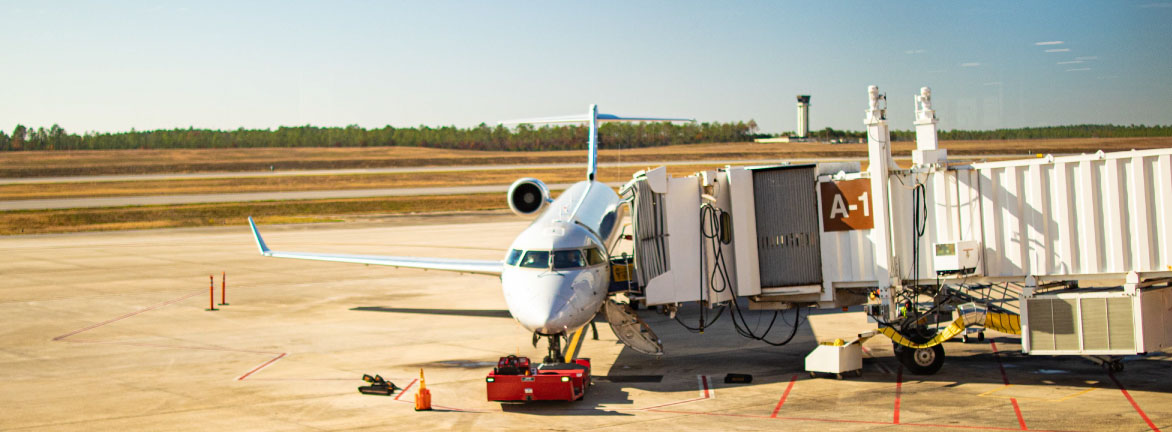
Objective 1C:
Increase Tallahassee International Airport’s economic impact on the region.
- Dollar value of Tallahassee International Airport’s economic impact. Target: $1 billion
- Annual total passenger traffic (enplanements and deplanements). Target: one million
- Annual total cargo (enplaned and deplaned). Target: 22 million pounds
- Acres of land leased near Tallahassee International Airport. Target: 100 acres
GOAL:
To be a leading community partner that actively connects residents to resources that remove economic and social barriers.
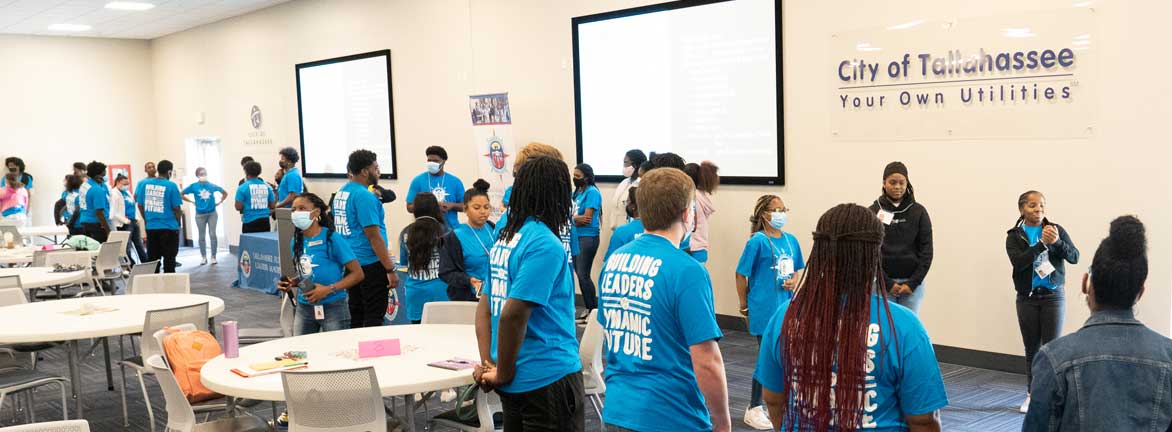
Objective 2A:
Support education, training, and job readiness for target populations.
- Percent reduction of disconnected youth. Target: 30%
- Number of TFLA participants that have moved on to higher education, trade school, certification programs, or military over a five-year period. Target: 500
- Number of TEMPO participants enrolled in a technical college or higher education institution over a five-year period. Target: 150
- Number of TEMPO participants that have found employment paying a “fair” or “living wage” over a five-year period. Target: 100
- Number of TEMPO participants completing a GED over a five-year period. Target: 150
- Percent increase in teen program participation at the Palmer-Munroe Teen Center. Target: 3% annually
Initiatives
- Enhance partnerships with community reentry programs.
- Promote the City’s Explore Program and Junior Cadet Program.
- Host annual job fair.
- Continue providing free bus passes to our area’s K-12 students.

Objective 2B:
Rehabilitate and enhance the existing housing inventory to reduce the cost of living.
- Number of homes served annually by energy efficiency grants, audits, and rebates to improve affordability and reduce homeownership housing costs. Target: 6,000
- Number of homes rehabilitated and/or receiving emergency repair. Target: 425
Initiatives
- Convert vacant student housing units into affordable housing units by working with Community Land Trust.
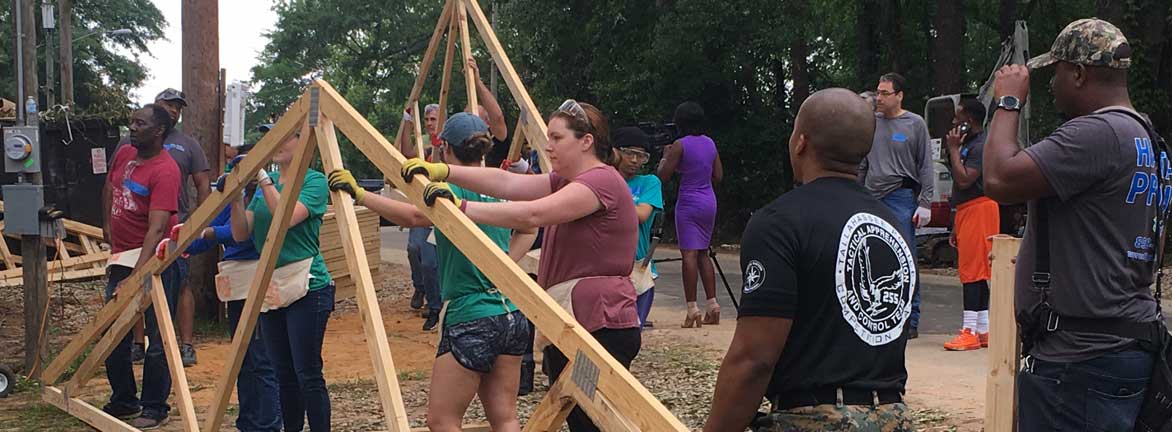
Objective 2C:
Facilitate and encourage the construction of affordable housing units..
- Number of new affordable homes or rental units built through the Community Land Trust. Target: 35
- Number of new homes built as a result of inclusionary housing programs. Target: 60
- Number of Habitat for Humanity homes built by City employees. Target: 10
- Number of down payment assistance grants awarded, creating pathways to home ownership. Target: 125
- Secure funding for Purpose Built Community and redevelopment of an additional 200 dwelling units at the Orange Avenue Housing Complex.
Initiatives
- Increase residential density within City limits.
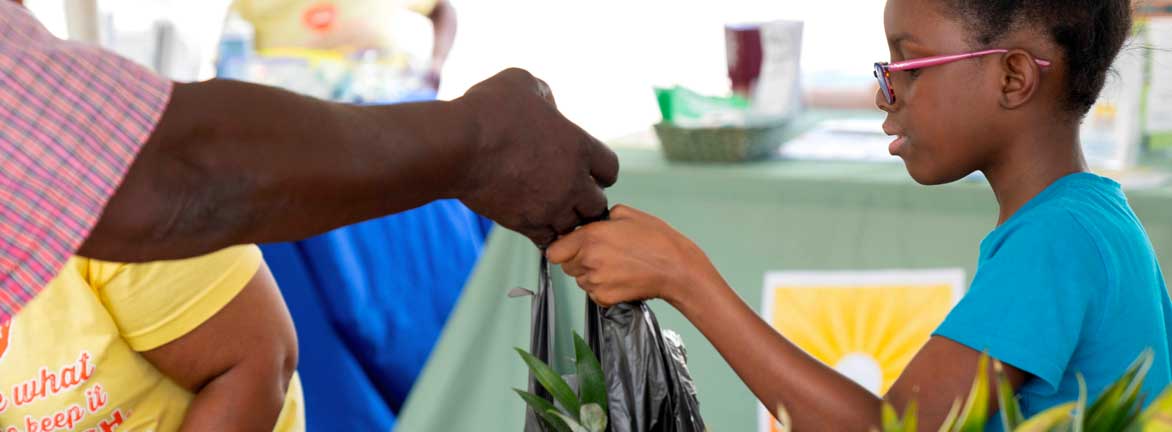
Objective 2D:
Support community health and wellness initiatives.
- Percent of residents living within 1 mile of a fresh food source. Target: 100%
- Create performance matrix to measure Return on Investment (ROI) for Community Human Service Partnership (CHSP) by 2024.
Initiatives
- Leverage community resources to increase access to recreational
facilities and programs.
- Cultivate partnerships to further the implementation of wellness programs.
GOAL:
To be an impact-focused workforce that is inclusive, pioneering, and technology-driven.
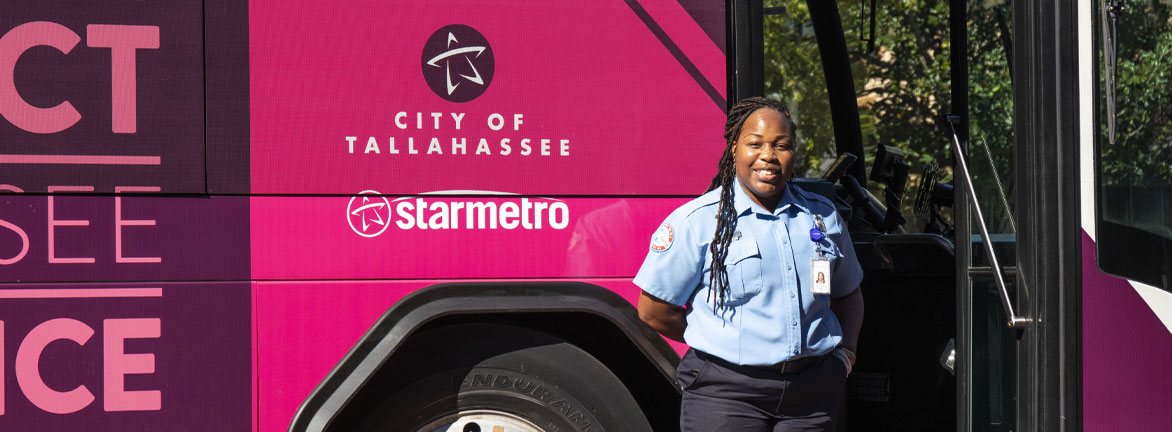
Objective 3A:
Attract, develop, and support the best talent.
- Rate of total employee turnover. Target: 6.5%
- Median number of days to fill a position from advertisement to offer. Target: 60 days
- Rate of employee satisfaction on annual Employee Engagement & Satisfaction surveys. Target: 90%
- Identification of City employees proficient in Spanish or American Sign Language.
- Grow employee participation in professional development programs by 10 percent by 2024.
Initiatives
- Recruit employees from local educational and vocational training centers.
- Have a City workforce that is reflective of community’s demographics.
- Develop and implement a City-wide Talent Development Plan.
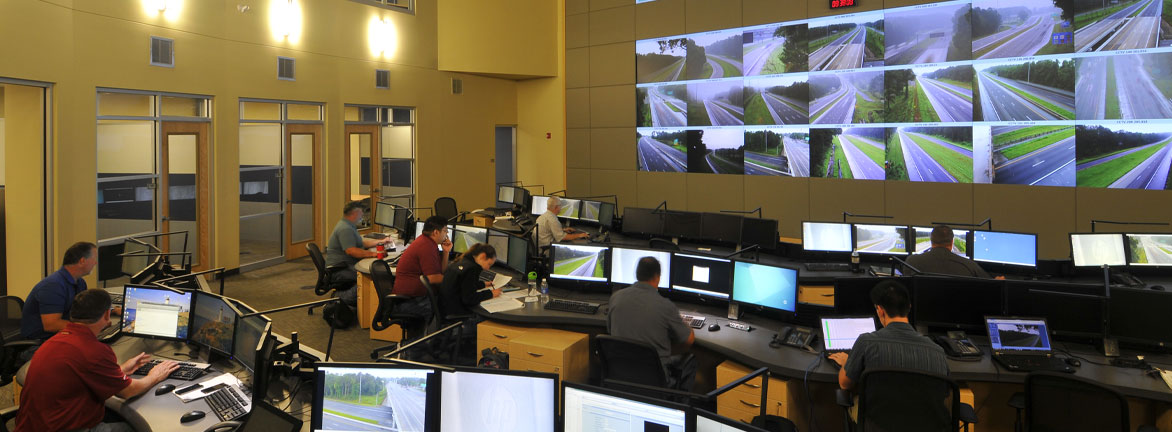
Objective 3B:
Leverage technology to deliver faster, more convenient services.
- Percent of payments received digitally. Target: 80%
- Implement online customer service and inquiry portal by 2022.
Initiatives
- Implement fully paperless internal services.
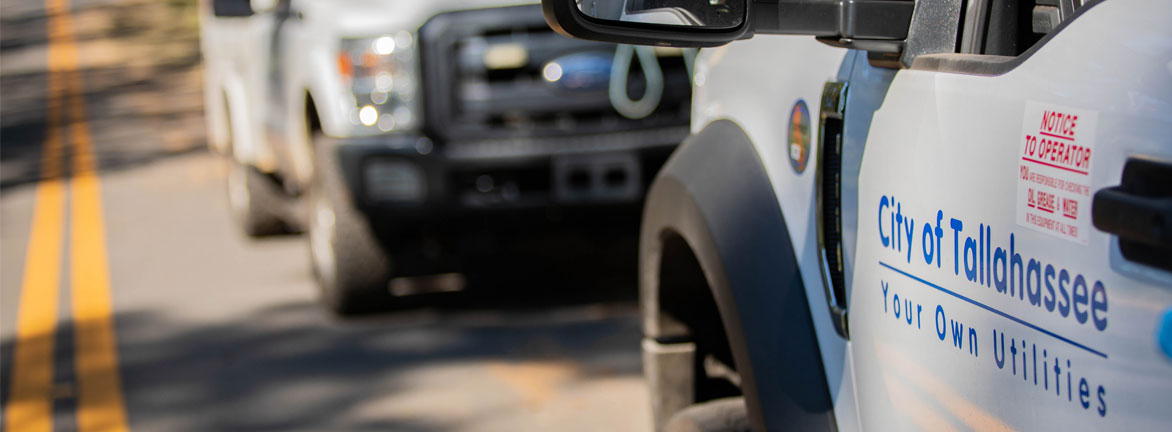
Objective 3C:
Map, analyze, and improve all work processes.
- Rate of availability for City fleet. Target: 96%
- Percent of budget document receiving ”Outstanding” ratings from the Government Financial Officers Association (GFOA). Target: 25%
- Achieve Sterling designation for Human Resources by 2022.
- Attain status as a “Top 100 Fleet.”
Initiatives
- Map, analyze, and enhance all departments’ procedures and processes.
- Evaluate service departments based on the customers they serve.
- Develop customer-centric service model within Procurement.
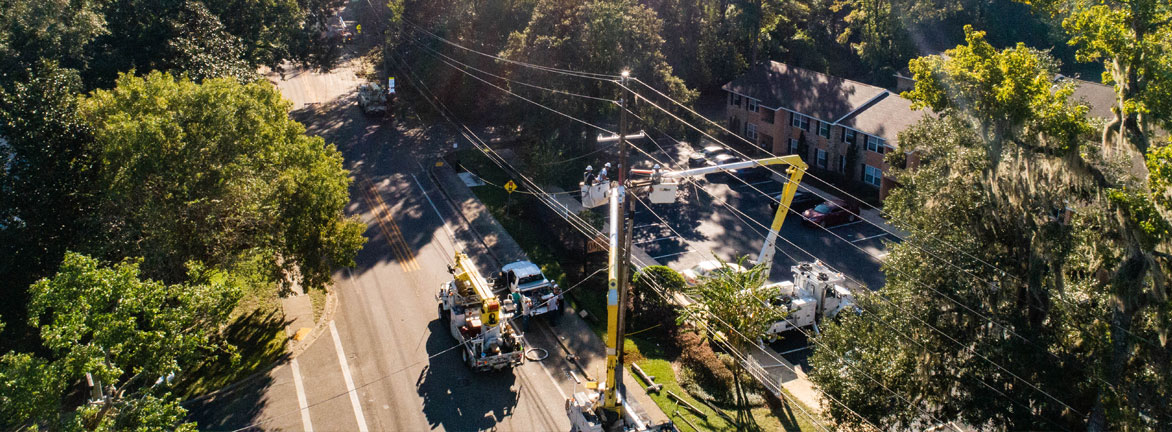
Objective 3D:
Maintain the City’s strong financial standing and fiscal stewardship practices.
- Percent of general employee pension funded. Target: 90%
- Percent increase of annual grant awards. Target: 5%
Initiatives
- Maintain a fully funded deficiency fund, in accordance with City policy.
- Maintain best-in-class municipal “AA” Bond rating.
GOAL:
To be the leading publicly owned utility that supports a growing and progressive community.
To be a city with an efficient public transit network supported by well-connected roads, sidewalks, transit
amenities, and public transportation.
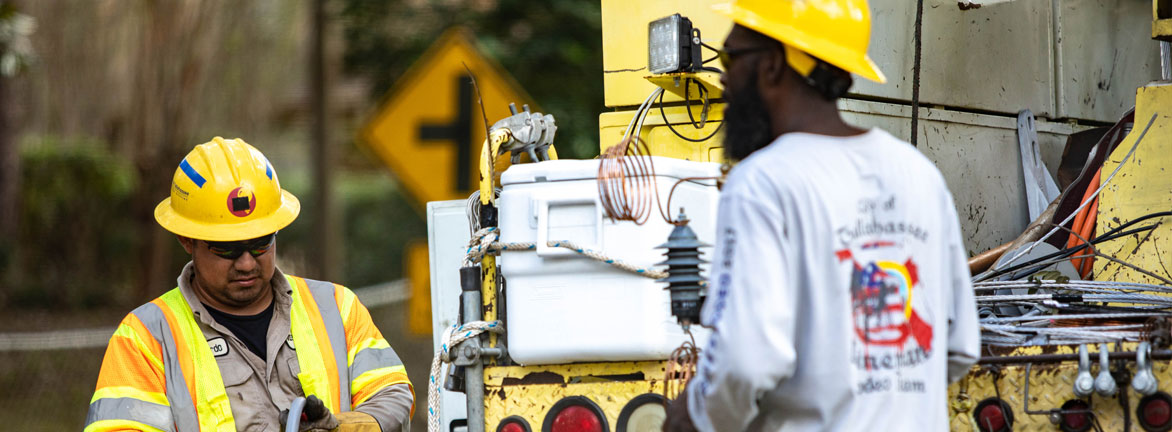
Objective 4A:
Be a leader in utility service delivery.
- Average customer outage response time for electric outages. Target: Less than 40 minutes
- Average customer outage response time for gas problems. Target: Less than 30 minutes
- Rate of availability for utility services (electric, gas, water, and sewer systems). Target: 99%
- Dollars invested in sewer collection system upgrades. Target: $61.3 million Target: 8.5%
- Provide electric and gas utility bills at or below the statewide average.
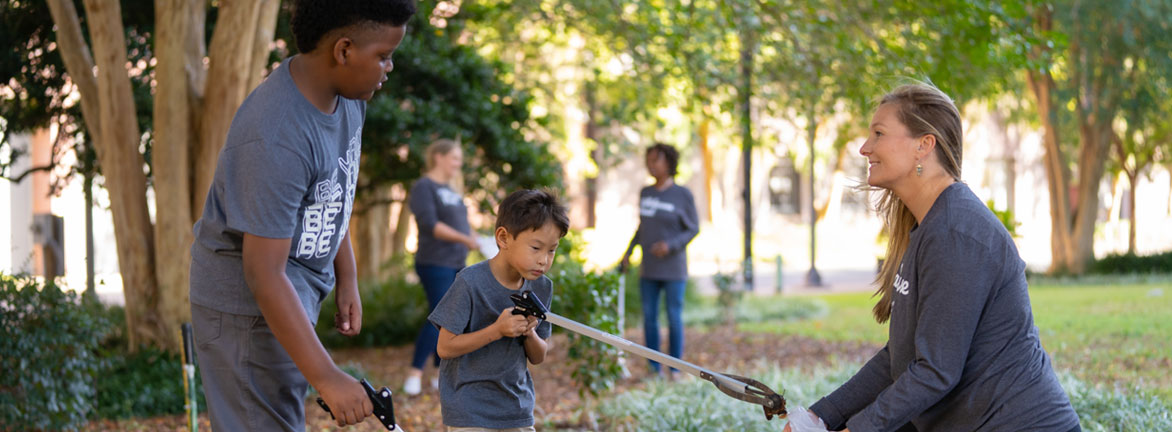
Objective 4B:
Be a leader in environmental stewardship.
- Percent of electric, hybrid electric, and CNG vehicles within inventory of City’s Light Duty Fleet by 2024. Target: 25%
- Tonnage of recyclables collected annually. Target: 13,000 tons annually & 75% recycling participation rate
- Develop and adopt the City’s Clean Energy Plan for 2050 by 2024.
- Remain a Top 3 municipal leader in the prevention of sewer spills during the next five years.
- Reduce the number of impaired water bodies.
Initiatives
- Continue the reduction of total greenhouse gas emissions for the City’s electric utility.
- Improve water quality by reducing harmful discharge and runoff.

Objective 4C:
Ensure safe and clean drinking water.
- Win the “Best Tasting Drinking Water in Florida” award.
- Complete construction of new water quality laboratory by 2021.
- Invest $44.9 million in the enhancement and maintenance of the potable water system over the next five years.
- Secure funding to continue the TAPP program over the next five years.
Initiatives
- Maintain best in class water quality.

Objective 4D:
Enhance the city’s network of roads, bike lanes, and sidewalks.
- Percent of City-maintained roads rated as “Good,” “Very Good,” or “Excellent.” Target: 70%
- Percent increase of annual grant awards. Target: 5%
- Complete Weems road and mixed-use trail project by 2024.
- Become a “Gold Standard” Biking Community by 2024.
Initiatives
- Increase percentage of residents using alternative modes of transportation to/from work.
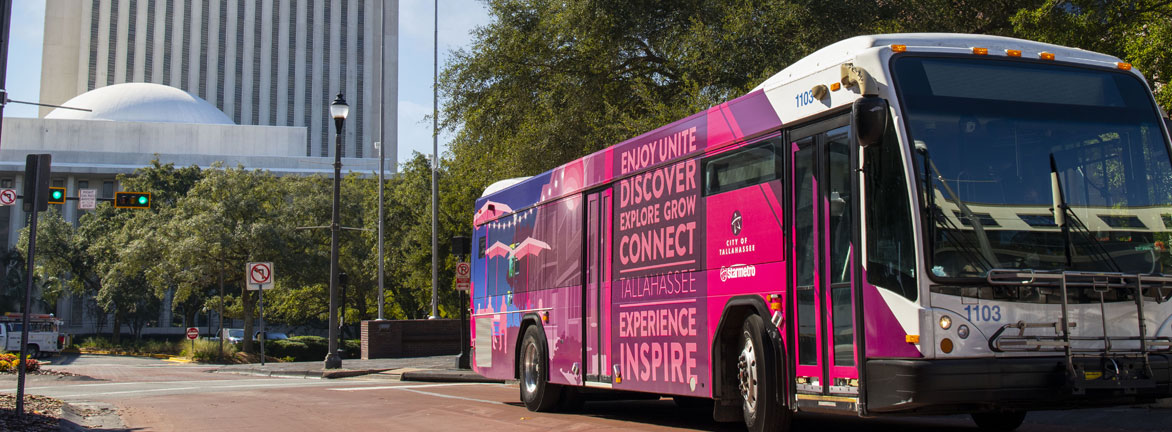
Objective 4E:
Ensure public transit is accessible, efficient, and equitable.
- Rate of on-time transit performance. Target: 90%
- Complete construction of a multi-modal transportation hub at C.K. Steele Plaza by 2022.
- Construction of the South City Transit Center by 2022.
GOAL:
To be a safe, resilient, and inclusive community.
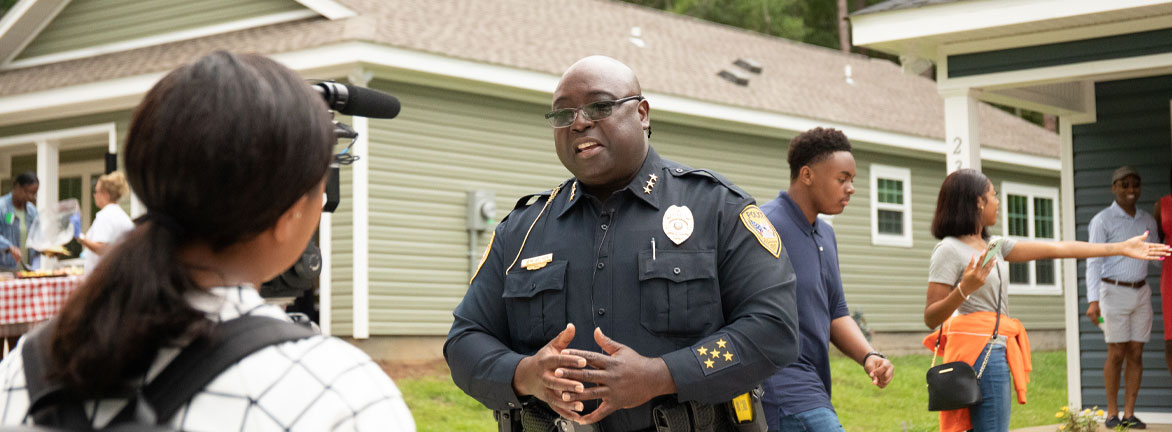
Objective 5A:
Implement proactive community-based solutions to enhance public safety.
- Number of neighborhoods participating in neighborhood watch programs. Target: 45%
- Number of community-oriented policing activities held annually. Target: 35
- Number of Community Liaison Officers deployed. Target: 15
Initiatives
- Increase public and private partnerships for citizen maintained and installed camera technology.
- Increase the number of neighborhoods participating in the Neighborhood Public Safety Initiative.

Objective 5B:
Crime prevention through effective policing and public awareness campaigns.
- Rate of annual success for all TEMPO participants. Target: 10% or less
- Reduce vehicle burglaries through crime prevention and community partnerships to reduce the number of stolen firearms. Target: 15
- Reduce violent crimes by partnering with community leaders and other law enforcement agencies. Target: 10%
Initiatives
- Enhance specialized knowledge needed to address cybercrime.

Objective 5C:
Training and readiness of public safety employees.
- Number of training hours per police officer annually. Target: 3
- Number of emergency preparedness training hours conducted, including training and exercises. Target: 5
Initiatives
- Increase annual community-oriented policing, sensitivity, fair and impartial policing, and de-escalation training for TPD officers.

Objective 5D:
Provide state of the art technology to support public safety initiatives.
- Percent of the City covered by ALS certified fire stations. Target: 100%
Initiatives
- Implementation of license plate reader (LPR) technology at strategic locations in the city to enhance traffic and public safety.
- Enhance City capabilities to proactively detect criminal activity.
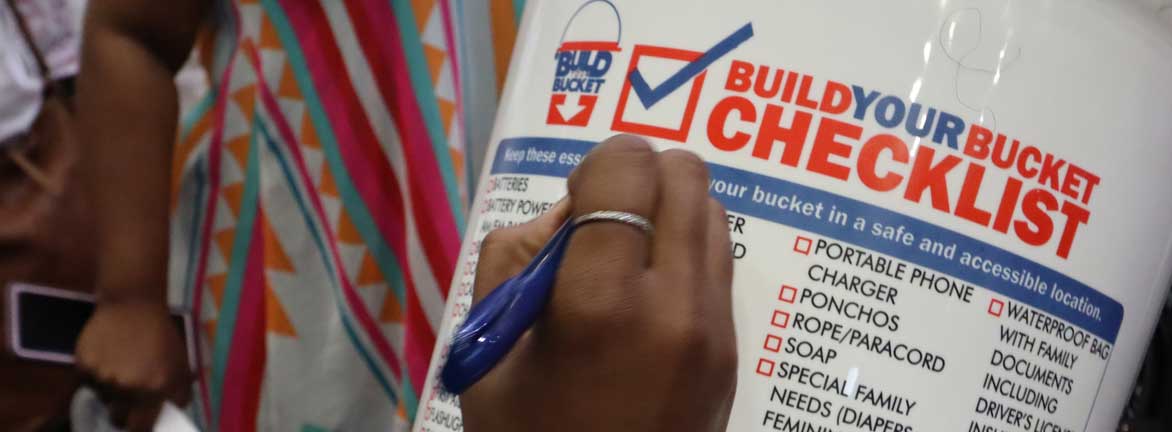
Objective 5E:
Enhance community preparedness initiatives.
- Number of attendees at disaster preparedness events. Target: 1,250
- Number of neighborhoods with PREP plans in-place. Target: 5
- Number of active shooter training seminars annually. Target: 25
- Facilitate annual table-top preparedness exercise for all response agencies.
Initiatives
- Identify faith centers that will serve as potential recovery staging sites for distribution of water, meals, and emergency goods.
- Facilitate annual large-scale community preparedness scenario, integrating all response and medical agencies.
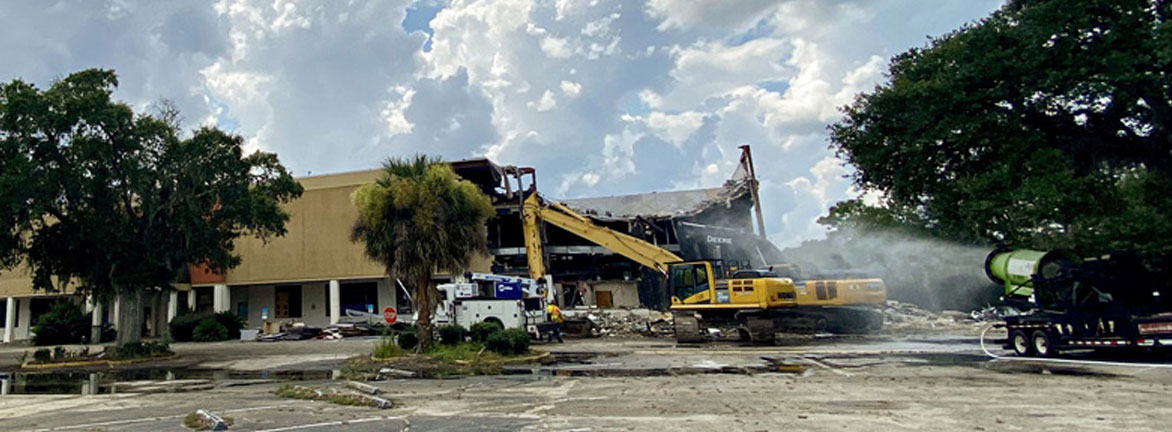
Objective 5F:
Create modern facilities to support community engagement and best-in-class public safety.
- Complete construction and begin operations at the new Public Safety Campus by 2024.
Initiatives
- Increase economic multiplier effect of police headquarters on the community and surrounding neighborhoods.
GOAL:
To enhance public trust through ethical business practices and transparent governance.

Objective 6A:
Infuse ethical practices into daily operations.
- Rate of compliance for annual employee ethics training. Target: 100%
- Rate of compliance for elected and appointed officials submitting financial disclosures with the State of Florida. Target: 35
- Adopt a No-Gift policy for all City employees by 2024.
Initiatives
- Increase public and private partnerships for citizen maintained and installed camera technology.
- Increase the number of neighborhoods participating in the Neighborhood Public Safety Initiative.

Objective 6B:
Enhance citizens’ access to city government operations and public meetings.
- Implement digital town hall at City Commission meetings by 2021.
Initiatives
- Enhance online transparency portal for registered lobbyists, city vendors, and the City’s budget.
- Regularly inform the public of progress toward achieving the targets within the 2024 Strategic Plan.
- Implement data-sharing with local law enforcement partners.
GOAL:
To be a creative and inclusive community with beautiful public spaces that protect and promote resources and
culture.
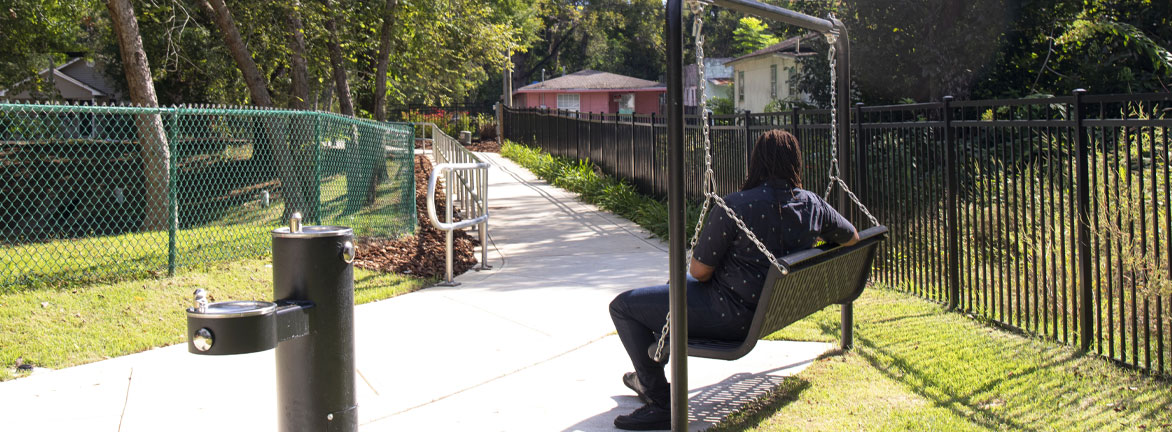
Objective 7A:
Maintain a safe, accessible, well-maintained network of parks, recreational facilities, greenways, and trails.
- Number of parks by 2024. Target: 100 parks
- Percent of residents of living within a 10-minute walk of a park or open space. Target: 100%
- Number of participants in City Parks and Recreation programs. Target: 612,000
- Complete construction of Market District Park by 2024.
- Complete construction of the second Senior Center by 2024.
- Achieve CAPRA accreditation (Commission for Accreditation of Park and Recreation Agencies) from the National Recreation and Parks Association by 2024.
Initiatives
- Continue with the implementation of Greenways Master Plan projects.
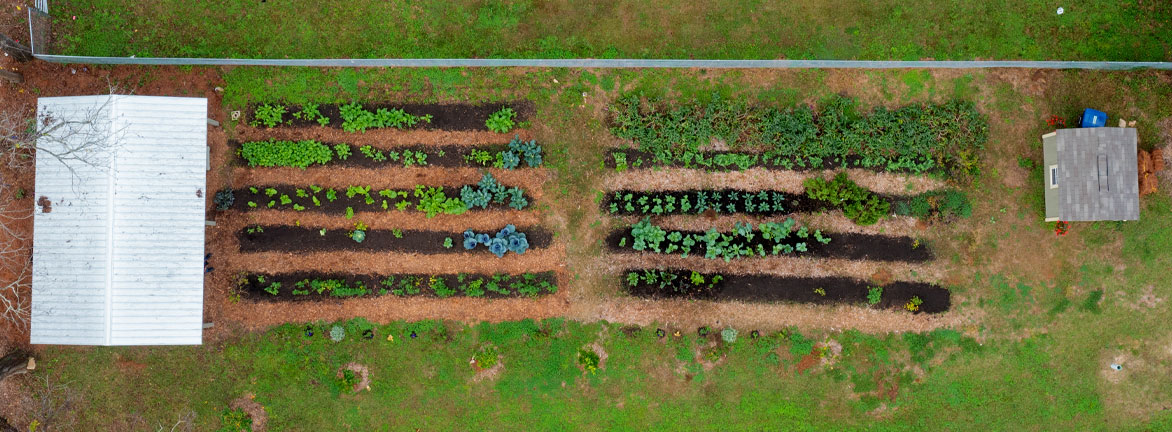
Objective 7B:
Enhance livability and preserve the unique characteristics of neighborhoods.
- Number of neighborhoods with an established liaison. Target: 225 neighborhoods
- Number of sidewalk projects completed annually. Target: 10
- Rate of voluntary compliance by property owners for code violations. Target: 90%
- Percent of urban forest tree canopy coverage. Target: 55%
- Achieve 30 consecutive years of “Tree City USA” status.
Initiatives
- Facilitate neighborhood entry signage and placemaking.

Objective 7C:
Keep residents and visitors informed about events and attractions in Tallahassee.
- Establish a Historic District / Museum Walk by 2024.
Initiatives
- Increase attendance at City-organized and City-sponsored festivals and cultural events year over year.
- Increase diversity and variety of City-sponsored events.
- Provide multiple platforms to inform citizens of local culture and City events.
1.3 Budget Overview
Return to Top
Developed through a year-round, multi-stage process involving public participation, City Commission input, and a focus on the priorities outlined in the City's Strategic Plan, the FY22 Budget totals more than $1 billion. This total includes $774.2 million for operating expenses and $262.4 million for capital investment.
For the FY22 Budget, significant factors in the short term include:
- A reduction in revenues resulting from economic uncertainty due to the ongoing effects of COVID-19.
- Increasing labor costs due to the Florida minimum wage increase and tightening of the labor market.
- Increasing operating and capital costs due to inflation.
Despite these pressures, the City is committed to providing the same high level of service for all activities in FY22.
While sales and use taxes are recovering from their lows in FY20, they did not increase to pre-COVID-19 growth levels in FY21. Ongoing uncertainty due to the emergence of virus variants and resulting economic market reactions may stall revenue growth in the short term. The American Rescue Plan Act (ARPA) provided an opportunity to offset these ongoing revenue reductions by funding over $12 million in estimated revenue losses over four years (FY20-FY23). The FY22 Budget includes $5.6 million in ARPA funding.
The FY22 Budget addresses increasing labor costs and the need to retain and recruit talented employees. The City Commission identified investing in the City's workforce as a top priority. The compensation package includes a 4.5% raise—with a minimum of $2,500 for lower-paid positions—and an increase in take-home pay through lower benefit costs. The budget also converts 93 positions from Other Personnel Services (OPS) to full-time equivalent (FTE), or permanent. The conversion of these positions is necessary to retain and develop talented employees who will provide services while maintaining flexibility, and allows departments to address current staffing needs.
Through negotiation, City leadership signed new agreements with its health insurance providers, and lowered employees’ paid share for coverage from 25% to 20% of their coverage cost.
|
Health Options - Retain 2021 health plan provision for 2022 and adjust the Employee/City share to an average over the plans of 20/80 from 25/75. Single rate complies with ACA Affordability.
|
| Premium FY22 |
Monthly Premium |
Average 25/75 |
| Employee |
City |
Total |
EE% |
City% |
| Employee Only |
98.78 |
667.00 |
765.78 |
13% |
87% |
| Employee +1 |
323.58 |
1,223.84 |
1,547.42 |
21% |
79% |
| Family |
642.22 |
1,462.62 |
2,104.84 |
31% |
69% |
The City also negotiated salary and benefit contracts with the Police and Fire Collective Bargaining units through FY23.
While the increase in the Consumer Price Index (CPI) averaged 1.9% from 2017 to 2020, it has increased by 3.4% in the first half of 2021. The FY22 Budget positions the City to achieve its strategic goals. Inflationary pressures will demand that we rely on the ongoing strategies of continuous monitoring, frequent communication, making adjustments when needed, and implementing practical, innovative solutions with the resources available.
The City continues to move forward with programs and initiatives that address critical needs and support strategic goals.
Public Safety
Crime is complex. There is much more to criminal activity than “bad people doing bad things.” When faced with a convergence of concentrated poverty, limited economic opportunities, and shortfalls in education, a person may choose crime out of desperation or a lack of hopeful outcomes for themselves or their families. The City of Tallahassee recognizes this and does not rely solely upon policing to fight crime. Sometimes what a community facing crime needs is not to have their hands cuffed but to receive helping hands. For this reason, the City will continue to seek understanding and innovative solutions that serve public safety needs in the community through:
- The Citizens Police Review Board, which inspects completed internal affairs investigations and provides recommendations
- The Tallahassee Police Department’s Citizens Advisory Council, which strengthens the relationship between law enforcement and the community
- And the Youth Citizens’ Advisory Council that provides an appropriate forum for open communication on public safety specific to youth.
The FY22 Budget continues funding for the most successful of the City’s initiatives for change, such as:
Tallahassee Engaged in Meaningful Productivity for Opportunity (TEMPO)
Disconnected youths are teenagers and young adults between the ages of 16 and 24 who neither work nor are in school. Based on crime statistics, this group of disconnected youth will make up the most significant number of potential gun violence victims over time. This vulnerable group includes high school dropouts, those with a prior criminal history, or those aging out of foster care. Without workforce training, vocational skills, diplomas, disconnected youth become further disengaged from the productive facets of society and are therefore subject to the appeal of criminal activity.
TEMPO, a City of Tallahassee community engagement and public safety youth program, steers disconnected youth to more viable alternatives. The program identifies, engages, and reconnects this group to educational and employment opportunities. The program can help end poverty cycles, reduce crime by providing economic hope, and reconnect local youth with the community through these activities.
By 2024, TEMPO aims to reduce the percentage of disconnected youth by 30%, impacting the lives of over 2,100 youth. The FY22 budget for TEMPO was increased to reflect the program’s growth.
Mental Health Crisis Response Unit (MHCRU)
While many first responders train in dealing with individuals experiencing a mental health crisis, they are not always best equipped to deal with the myriad of service requests routed to the Consolidated Dispatch Agency (9-1-1 call center.) Several cities across the country have begun to redirect calls for nonviolent crises away from law enforcement to a designated response team of trained mental health and social work professionals.
Established as a pilot program in FY21, the MHCRU consists of a licensed mental health professional, a Tallahassee Fire Department Paramedic or Emergency Medical Technician, and a Crisis Intervention Team-trained Police officer. Equipped to provide immediate medical or psychological stabilization and assessment, this team will provide referrals for additional services beyond the initial incident.
Over time, this program could evolve into a 24/7 response unit to include additional human service partners who may provide services during response or provide proactive outreach to vulnerable communities to mitigate crises. In one highly successful model in Eugene, Oregon, the response teams have diverted 18% of overall emergency call volume and saved over $8 million in public safety spending annually.
Tallahassee Future Leaders Academy (TFLA)
TFLA is a premier leadership program that provides teens with mentorship and summer employment for over one hundred participants annually.
The training related to job readiness, leadership, careers, customer service, financial literacy, and college campus enrichment provides new opportunities that may not otherwise be available. Partnerships with local institutions of higher education enhance youth exposure to college campuses.
Community Resilience
At the May 19, 2021 workshop, the City Commission approved a plan that will provide $18 million in American Rescue Plan Act (ARPA) funds for investments and programs to address essential community needs in the wake of COVID-19 through:
- Four homeless shelters.
- Incentives for affordable rental projects.
- Down payment assistance programs.
- Neighborhood resilience measures.
- Additional Community Human Services Partnership allocations; and
- Various other efforts range from small business support to addressing vaccine hesitancy.
The City and County coordinated their plans to allocate these resources to the community, providing joint funding of certain programs to maximize service impacts. This coordination was directed by agencies, neighborhoods, and those most impacted by COVID-19.
Housing Programs
Increases in the rate of homeownership often precede declines in both property and violent crimes. While the reason behind this relationship is not entirely understood, homeowners likely form deeper connections of social and economic investment with the community. These connections lead to stronger social bonds that spread, affecting many characteristics of the area and reducing crime. Homeowners are likely to care more for their properties and street, lead stable lives, and be less likely to commit crimes themselves.
The City operates several housing programs with multiple goals in mind, including assisting lower-income individuals and families and reducing the impact of reducing crime:
- Habitat for Humanity Partnership
Habitat for Humanity’s vision is of a world where everyone has a decent place to live. Habitat works toward that vision by building strength, stability, and self-reliance, in partnership with families in need of affordable housing. Habitat homeowners help build their own homes alongside volunteers, and they pay an affordable mortgage on their homes. The City provides funding and volunteer hours (more than 1,335 hours to date) to build Habitat houses.
- Emergency Home Repair Program
The Emergency Home Repair Program (EHRP) aims to improve the living conditions of low-income homeowners by removing health and safety hazards and architectural barriers from their homes. The program funds emergency repairs and accessibility improvements to homes owned and occupied by income-eligible persons.
- Code Enforcement Repair Program
The Code Enforcement Repair Program provides monetary assistance to owner-occupied, income-eligible homeowners who have received notice of exterior code violations while improving and preserving neighborhoods. A loan of up to $2,500 per unit is available to help make needed repairs to bring the home into compliance and under certain conditions.
- Storm Damage Mitigation Program
The Storm Damage Mitigation Program provides grant assistance to low-income homeowners to harden their homes against future storms or natural events.
- Owner-Occupied Rehabilitation Program
Rehabilitation and preservation of owner-occupied housing is a priority for the City of Tallahassee. Committed to improving the quality of affordable housing, the City allocates a substantial portion of its annual housing budget to the Owner-Occupied Rehabilitation Program (OOR). The goal of OOR is to enhance and strengthen neighborhoods through the rehabilitation of owner-occupied housing.
- Inclusionary Housing
The Tallahassee City Commission passed an ordinance in 2005 requiring new developments in certain areas of the City with 50 housing units or more to sell 10 percent of their units at an affordable price. The ordinance establishes the sales price range. Developers can pay a fee instead of building the units. The money collected is used to construct future affordable housing units. The units are sold to income-eligible homebuyers and are subject to resale restrictions.
Neighborhood First
Neighborhood safety is about more than just the absence of crime. It is about the opportunity for residents to build relationships and enjoy vibrant public spaces, accessible social supports, infrastructure that supports resiliency in times of stress, and a shared trust between the government and its constituents to allow for partnership at all levels. The City of Tallahassee works with neighborhoods to build partnerships that proactively address crime prevention, disaster response, and safe community spaces.
Neighborhood First is a multistep planning process that assists neighborhoods in participating in the Neighborhood Public Safety Initiative (NPSI.) Neighborhoods develop an action plan to address community priorities. NPSI addresses public safety by focusing on crime prevention and education, community beautification, community empowerment, and volunteerism.
Sustainability, Community Preparedness, and Resilience
Both single catastrophic events and long-term sustained pressures, such as concentrated poverty, can cause a community to experience increases in criminal activity. For the City of Tallahassee, resilience is about strengthening infrastructure reliability, protecting a robust natural environment and local economy, building up our adaptive capacity, and empowering self-sufficiency across the community. The Resilience Office partners across city government and stakeholders to build our community’s capacity to thrive in the face of external threats or internal weaknesses. The Office develops a cohesive long-range strategy and oversees effective initiatives throughout City plans, programs, and policies.
Community Human Service Partnership (CHSP)
CHSP helps prevent criminal activity through many approaches, from helping those with addictions that may seek illegal sources of income, to serving as catalysts for economic or educational opportunities to ascend out of poverty.
CHSP is an innovative collaboration between Leon County and the City of Tallahassee. It was established to most effectively distribute community funds for human services. Historically, cities are less often involved in providing nonprofit human service funding, as states and the federal government offer these organizations grants and contracts. By providing funding, this program can multiply the resources available to the community. While the City cannot fund all the activities for these nonprofits, agencies use local financing to bring additional state and federal dollars for the benefit of the community.
The funded organizations all have different approaches that can ‘holistically’ impact crime, whether through affecting youth long before legal transgressions occur or assisting those with mental health issues.
StarMetro – Public Transportation
The City administers a comprehensive bus transportation system with over 15 routes, including night and weekend service. Fares are priced below the actual cost of the ride, while some residents ride for free.
This public transportation allows lower-income workers access to more workable hours and employment than would otherwise be available for those without personal vehicles or augmenting their transportation such as a bike or scooter. Without this mobility, some would be without work and more likely to engage in criminal activity. It also allows riders to save money otherwise spent on personal transportation to use for education or starting a business so they may increase their income in the future or for a down-payment on a home.
While grants and some fare revenue support the bus system, the City transfers over $6 million per year to fund transportation needs in the City, including reduced fares and free transport for eligible citizens. Leon County Schools provide choices to students to attend schools outside of their zones, and StarMetro allows K-12 students to ride for free to enable these educational opportunities.
Parks & Recreation (P&R) – Youth Activities
P&R operates several Community Centers that engage with the general public and juveniles at risk for criminal behavior.
The Palmer Monroe Teen Center creates a positive environment for local teens to interact, discuss concerns and issues they are struggling with, and learn interpersonal skills to reduce conflict in their sphere. The Center focuses on attractive programming, adult mentoring, educational assistance, restorative justice collaboration, and the use of cutting-edge initiatives developed to engage teens through skills-based training, fun and safe entertainment outlets, and community-service involvement.
Citywide
Every year, the City exhibits its versatility in a comprehensive approach to the ways it seeks to solve complex, multi-layer social issues. Further, these solutions are measured and revisited each year through the budget process to ensure effective community service/public safety investment outcomes.
Beyond these programs, City employees make a difference in this community with their dollars and time. Before the pandemic thwarted many philanthropic efforts, employees participated through monetary contributions and volunteer time, including:
- United Way contributions of $101,249.
- Relay for Life fundraising of $17,847, over $95,000 over the last six years, with 400 volunteer hours.
- Almost three tons of non-perishable food donated for America’s Second Harvest of the Big Bend. Combined with cash donations from StarMetro’s partners, this provided more than 4,762 meals for residents in need.
- Over 240 pints of blood donated by City Employees from City Hall, the Gemini Building, and the Water department in a single year.
- More than $125,000 donated to community organizations via payroll deduction, with over $434,000 in the past four years.
In short, the City of Tallahassee will continue to innovate, approaching age-old issues and novel crises with both classic and cutting-edge solutions. The City can support its current efforts while exploring state-of-the-art programs because we strive, every day, to be the national leader in public service.
READ THE BUDGET-IN-BRIEF
1.4 Millage Rate
Return to Top
The millage rate is the amount per $1,000 used to calculate ad valorem taxes (property taxes). The rate is multiplied by the total taxable value to determine the property taxes due.
The City of Tallahassee has maintained a millage rate of 4.1 for six years, lower than many of its peers across Florida and other Leon county governments. A millage rate keeps the cost of homeownership affordable while still providing high-quality services.
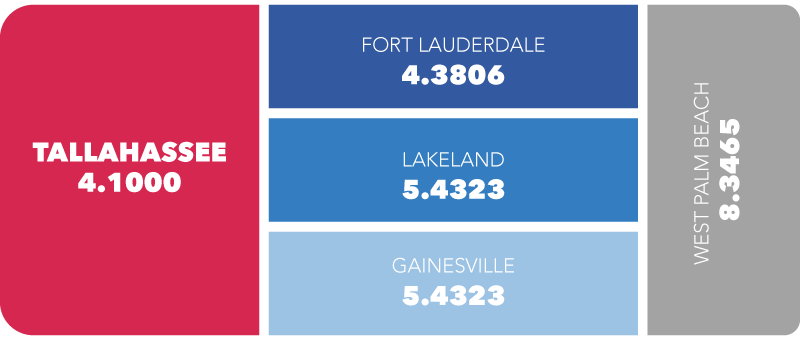
1.5 Municipal Cost Comparison
Return to Top
When measuring costs to citizens, the City compares itself to a group of eleven cities that share similar demographics, services provided, and square miles served. The Municipal Cost Comparison below contrasts what citizens, both residential and commercial, pay for municipal services.
City utilities undergo regular fee studies to ensure that costs for services are recovered and paid for by those that benefit. The municipal cost comparison, however, demonstrates the competitiveness of rates compared to peer cities across the state. The City ranks as one of the most affordable to citizens year after year.
1.6 Population & Other Community Statistics
Return to Top
Tallahassee experiences consistent population growth. The City plans for a continued increase of its services. When making infrastructure decisions, the organization considers not just today’s demands but also tomorrow’s needs.
To view other statistics and trends that formulate the budget and plans for the City, please click here to read the Supplemental Demographic and Economic Information section.
2.1 Organizational Chart
Return to Top
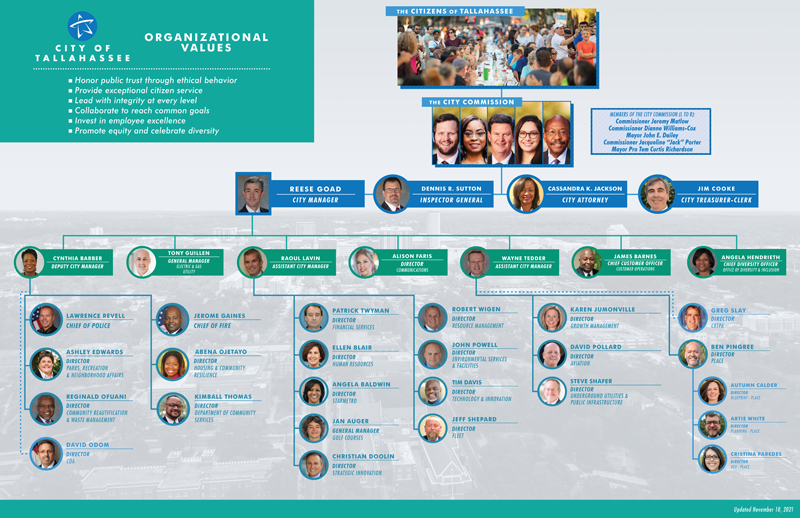
Download the Organizational Chart
2.2 Fund Descriptions & Structures
Return to Top
A fund is an accounting entity that documents activities. Fund accounting prioritizes accountability over profitability. Separate funds ensure revenues are appropriately related to expenditures.
Government funds support core city services where those paying indirectly benefit from the services. Enterprise funds are self-supported by user fees and charges. These operate similar to private businesses.
Below are summaries of important appropriated funds.
This fund supports many core city services, including police, parks and recreation, road maintenance, housing initiatives, economic development, land use, environmental regulation, and animal services. The general government also provides an operating subsidy to Star Metro, the city's transit system.
Fund Type
Government
Surplus
City policy determines the use of any operating fund surplus at year-end and a target level for the deficiencies reserve. Any surplus at year-end is first added to the deficiencies reserve until the amount reaches the target. After fully funding the deficiencies fund, any remaining balance supports the subsequent year’s operating budget, up to a maximum of 5% of general government operating expenditures, and to buy down debt-financed capital improvement projects.
General Fund Transfer
$4.3 million in new funding is budgeted to support projects in FY22.
Operating Reserve
The FY22 revenue budget does not include transfers from General Fund Operating Reserves in FY22.
Other
Deficiencies Reserve: If the subsequent fiscal year ends with an operating deficit due to unforeseen circumstances, up to 5% of FY21 year-end surpluses will be available from the Deficiencies reserve as needed.
Fleet Reserve: The FY22 contribution is $1.9 million
RR&I: Undesignated balance set at a maximum of 3% of general government capital projects.
The City’s Growth Management Department is responsible for enforcing the City’s building codes through review of building plans, permitting, and the inspection process. Specific actions include, ensuring that planned construction is in compliance with applicable codes, authorizing utility connections and issuing certificates of occupancy, providing centralized intake and coordination of all permit applications, and administering contractor licensing regulations and enforcing the rooming house ordinance.
Established in 1902, the Tallahassee Fire Department (TFD) is a municipal fire department that provides fire suppression and emergency medical services in the City and the unincorporated areas of Leon County, Florida. The department is charged with the responsibility of protecting lives, property and the environment from hazardous conditions that threaten our community. This mission is accomplished through the provision of prevention and protective services specific to the incident need.
Fund Type
Enterprise
Surplus
Retained for fire operating and capital costs.
General Fund Transfer
No transfer.
Operating Reserve
No reserve.
Other
Not applicable.
The Electric Utility serves over 128,000 customers in a 221-square mile service territory. It is the fourth largest municipal electric utility in Florida, and the 27th largest of over 2,000 municipal systems in the United States. The utility is comprised of six major divisions: Finance and Administration, Power Delivery, Energy Supply, System Operations, System Compliance, and System Integrated Planning. The Electric Utility develops 10-year sales forecast annually to use in the annual budget process.
Fund Type
Enterprise
Surplus
Operating fund balance after General Fund transfer minus bond reserves used to fully fund the operating reserve, with the balance designated for electric system capital projects.
General Fund Transfer
The transfer is based on CPI. The transfer for FY22 is $32.3 million.
Operating Reserve
The operating reserve is comprised of four subcomponents, with the primary purpose aimed at providing working capital. The working capital component is targeted with having a balance of 60 to 90 days of operating expenses. The other three components are fuel risk management, emergency reserve and rate stabilization.
Other
RR&I: Transfer budgeted at a level equivalent to depreciation expense as provided in the Comprehensive Annual Financial Report (CAFR).
The City of Tallahassee's Natural Gas Utility has provided clean, safe, economical and reliable natural gas to residents and businesses in a growing service area for over 60 years. The utility safely provides natural gas energy through hundreds of miles of underground gas mains, which serve over 34,000 customers in the Leon, Gadsden, and Wakulla areas. The highly trained staff works to ensure the integrity and dependability of the distribution system, and to assist customers with energy conservation and cost savings through natural gas use.
Fund Type
Enterprise
Surplus
Designated to fully fund the operating reserve and thereafter to fund gas system capital projects
General Fund Transfer
The transfer is based on CPI. The transfer for FY22 is $3.1million.
Operating Reserve
Funded at 25% of the previous year’s General Fund transfer. Used to meet General Fund transfer, if required.
Other
RR&I: Transfer budgeted at a level equivalent to depreciation expense as provided in the applicable rate study.
The City’s water system currently services 86,000 connections with approximately 9 billion gallons of water per year. This around-the-clock operation employs 27 water wells and treatment facilities, 8 elevated storage tanks, 6,900 fire hydrants and over 1,200 miles of water distribution piping.
Fund Type
Enterprise
Surplus
Designated to fully fund the operating reserve and thereafter to fund water system capital projects.
General Fund Transfer
The transfer is based on CPI. The transfer for FY22 is $3.8 million.
Operating Reserve
Funded at 25% of the previous year’s General Fund transfer. Used to meet General Fund transfer, if required.
Other
RR&I: Transfer budgeted at a level equivalent to depreciation expense as provided in the Comprehensive Annual Financial Report (CAFR).
The City of Tallahassee's Sewer Utility is responsible for collecting, treating and disposing of wastewater, along with treating commercially pumped sewage. Wastewater is treated in the City’s Advanced Wastewater Treatment plant to a standard that more than exceeds regulatory requirements, as part of the City’s commitment to protecting the environment.
Fund Type
Enterprise
Surplus
Designated to fully fund the operating reserve and thereafter to fund sewer system capital projects.
General Fund Transfer
The transfer is based on CPI. The transfer for FY22 is $5.2 million.
Operating Reserve
Funded at 25% of the prior year’s General Fund. Used to meet General Fund transfer, if required.
Other
RR&I: Transfer budgeted at a level equivalent to depreciation expense as provided in the Comprehensive Annual Financial Report (CAFR).
The Aviation Fund supports operations at the Tallahassee International Airport (TLH) including the Aviation Department’s six divisions as well as the Airport Police and Airport Parking divisions. The Fund also makes contributions to the Fire Fund for the Tallahassee Fire Department’s operations at the airport.
The Airport hosts three airlines (American Airlines, Delta Air Lines and Silver Airways) that deliver non-stop service to seven destinations, and provides amenities to customers including valet parking, long- and short-term parking, a cell phone parking lot, rental car options, a public waiting area, business center, dining options, and more. As part of the City’s five-year strategic plan, Tallahassee International Airport will be constructing an International Passenger Processing Facility, with a five-year goal of making a $1 billion annual economic impact.
Fund Type
Enterprise
Surplus
Retained within fund and allocated according to airline use agreement.
General Fund Transfer
No transfer to General Fund. Full recovery of cost.
Operating Reserve
Minimum of 1/12th of operating and maintenance budget for Airport designated for unanticipated non-recurring expenditures.
Other
RR&I: Not applicable.
The City has operated StarMetro, a public transit system since December 1973. StarMetro provides fixed route and special transportation services under provisions of the Americans with Disabilities Act (ADA) and serves as the Community Transportation Coordinator (CTC) for Leon County. Its services include 12 crosstown routes, six night routes, and 10 university routes.
The Solid Waste Fund provides garbage, recyclable materials, bulk and yard waste collection for all residential customers citywide, and garbage and recyclable materials collections for commercial customers. Currently, the City serves 47,936 residential, 15,415 commercial, and 1,835 commercial recycling service points.
This includes residential bi-weekly curbside collection of bulky items, yard waste, electronics, and white goods, dumpster services for commercial customers collected by front-end loading trucks at night, up to six times per week, commercial container service with roll-off or hook trucks up to six times per week and commercial recycling up to five days per week, as well as other enhanced services. Dead animal removal and street sweeping services are also provided by this fund.
Fund Type
Enterprise
Surplus
Retained for rate stabilization reserve.
General Fund Transfer
Each year the transfer is increased by CPI. The transfer for FY22 is $2 million.
Operating Reserve
No Reserve.
Other
RR&I: Not applicable.
The Stormwater Fund manages and develops infrastructure for drainage, flood prevention and retention of storm water run-off to prevent pollutants from entering the aquifer. This includes capital project over-sight, maintenance of drainage infrastructure such as retention ponds and drainage outfalls, monitoring of lakes and ground water and raising pub-lic awareness of the environmental impacts of pollution, such as the Think About Personal Pollution (TAPP) program.
Fund Type
Enterprise
Surplus
Retained for stormwater system capital projects.
General Fund Transfer
The transfer to the General Fund represents administrative cost sharing only.
Operating Reserve
No Reserve.
Other
RR&I: Maximum of 5% of capital projects funding sources, with a minimum level of 3%.
The Golf Fund supports Hilaman Golf Course, which offers a community-wide golf experience through daily rounds, driving range use, charity events, tournaments, and more. Hilaman also has a Pro Shop, restaurant, and outdoor deck area that provide a well-rounded experience. The course is open daily from 7:30 a.m. until dark, and course operations are led by a General Manager and two full-time staff members: a foreman and a supervisor of course maintenance. In addition, Hilaman has over two dozen part-time employees who help with a variety of day-to-day operations.
The City Commission adopted an ordinance on September 10, 1986 establishing the Cemetery Perpetual Care Trust Fund (PCTF) for the maintenance and operation of the City cemeteries. Proceeds from this trust are transferred annually to support operations within the Cemetery Division. The City of Tallahassee owns and maintains five cemeteries totaling 133 acres. The City also provides maintenance services for the historic Plantation Cemetery.
Fund Type
Trust
Surplus
Retained for cemetery operating and capital costs.
General Fund Transfer
No transfer.
Operating Reserve
No reserve.
Other
Not applicable.
View full schedule of major and nonmajor funds.
View matrix of the relationship between departments and funds.
2.3 Basis of Budgeting
Return to Top
Budgets for general operation funds (General, StarMetro and Golf Course Funds) are prepared on a modified accrual basis. The obligations for these funds (i.e., outstanding purchase orders) are considered expenditures, but revenues are recognized only when they are measurable and available. At the end of the fiscal year, open encumbrances are reported as reservations of fund balance. The operating budget does not include expenses for depreciation.
The budgets for the City’s utilities (Electric and Underground) and other enterprise funds (Aviation, Building Inspection, Solid Waste, Fire, and Cemeteries) are budgeted on a full accrual basis. Expenditures are recognized when a commitment is made (e.g., through a purchase order). Revenues are also recognized when they are obligated to the city, such as when utilities distribute bills.
The basis of budgeting is the same as the basis of accounting used in audited financial statements. Budget and accounting procedures are subject to modifications to comply with generally accepted accounting principles (GAAP) as well as the standards of the Governmental Accounting Standards Board (GASB).
2.4 Financial Policies and Guidelines
Return to Top
There are several statutory requirements, internal policies, and other provisions that direct the development of the budget and its implementation throughout the year.
Florida Statutes, Chapter 166 – This statute authorizes municipalities to levy taxes, issue licenses, and set user fees to raise money necessary to conduct municipal government activities. This chapter also requires that local governments adopt a balanced budget. The tentative balanced budget must be posted on the municipality’s official website at least 2 days before the budget hearing, held pursuant to s. 200.065 or other law, to consider such budget. The final adopted balanced budget must be posted on the municipality’s official website within 30 days after adoption.
Florida Statutes, Chapter 200 – This statute establishes procedures for adoption of local government annual budgets and limits ad valorem taxes to 10 mills. This statute also requires that local governments appropriate a balanced budget in which anticipated revenues and expenses are equal. Failure to comply with the provisions of the statute could result in loss of state revenue sharing and/or ad valorem taxes.
Ad Valorem Taxes – The Property Appraiser provides an annual estimate of taxable property values for the preceding year. Based upon adopted millage rates, municipalities are required to budget 95% of the gross taxable value for operating purposes. The city typically budgets 97%. In FY 2004, the city’s millage rate increased from 3.2 mills to 3.7 mills. This was the first millage rate increase since FY 1991. As a result of property tax reform legislation enacted by the Florida Legislature, the millage rate in the FY 2008 approved budget was reduced to 3.1686 mills. Due to the passage of Amendment 1 on January 29, 2008, the city’s millage rate for FY 2009 was 3.2115 mills. In FY 2010, the City Commission voted to increase the millage rate to 3.7 mills. The FY 2016 approved budget included a millage increase from 3.7 mills to 4.2 mills and in FY 2017 the millage was reduced to 4.1 mills. For FY 2020, the millage remains at 4.1 mills.
Florida Statutes, Chapter 202 – The Communication Services Tax consolidates a variety of taxes formerly imposed on telecommunication, cable, home satellite and related services. Opting for the highest rate allowable by law, 6.1%, the City of Tallahassee is required to forego permit fee charges for use of city right-of-way.
Community Redevelopment Agency, Florida Statutes Chapter 163, City of Tallahassee Ordinance 00-O-51 and 04-O-60 To encourage economic development, the City Commission established a Community Redevelopment Agency (CRA) and designated an initial district (Frenchtown) of approximately 1,400 acres for redevelopment. A second district (Downtown) was approved in June 2004. Each CRA district is entitled to 95% of the ad valorem tax increment generated within the district and the proceeds may be used only for improvements in the district.
Downtown Improvement Authority, Florida Statutes Chapter 71-935 – Established by a special act in 1971, the Downtown Improvement Authority may levy an additional ad valorem tax, not to exceed one mill, on properties within the district. Proceeds are used for improvements in the district and are administered by a separate Board of Directors.
Comprehensive Plan – The Tallahassee-Leon County 2010 Comprehensive Plan was originally adopted by ordinance in FY 1990 and is updated with biannual amendment cycles. The Plan includes capital improvements, transportation, historic preservation, utilities, recreation, and other elements which provide a framework for allocating budget resources. The Capital Projects Summary includes a listing of capital projects that address Comprehensive Plan initiatives by eliminating deficit levels of services or by maintaining existing levels of service.
Financing Policy, No. 224 Commission Policies – The financing policy establishes guidelines for distribution of year-end surpluses, transfers from the utilities to the General Fund, types and amounts of operating reserves, and funding for capital projects from undesignated fund balance year-end revenues. The policy also provides for full recovery of cost for enterprise funds, limits non-utility fee increases to a maximum of 20% per year unless otherwise approved by the City Commission; and allows discount fees for recreational programs for youth, seniors, and disabled citizens. The “Finance Policy Summary” chart shows the requirements of the policy as applied to each fund.
Risk Management Policy/Self-Insurance, No. 214 Commission Policies – This policy creates an internal service fund for payment of anticipated claims and judgments for coverage areas defined in the policy. In addition, a special Insurance Reserve Fund is established and funded to meet unanticipated losses from catastrophic events or claims in excess of the Risk Management Fund. This reserve is set at 150% of the average claims for the past five years or $3,000,000, whichever is greater.
Capital Project Management, No. 218 Commission Policies – This policy provides for preparation of an annual capital budget and for a five-year capital improvement plan. The policy also defines roles and responsibilities of city departments and management regarding contracts, supplemental appropriations, over expenditures, and project administration. The use of capital project overhead charges as an operating budget funding source also is established by this policy.
Local Option Sales Tax Management, No. 232 Commission Policies – This policy establishes the authority to provide advance funding for local Florida Department of Transportation (FDOT) projects for any project or phase of project included in the FDOT five-year work plan. It allows for advance funding without an agreement for repayment after conducting a public hearing. The policy also authorizes the use of short-term debt to cover cash flow shortages that may result from this practice.
Debt Management Policy, No. 238 Commission Policies – The debt management policy, along with an analysis of the city’s compliance with the policy, is included in the capital budget summary and in the capital improvement plan. Section 104 of the City Charter also specifies that general obligation debt will not exceed 20% of the assessed taxable valuation. Florida Statutes require that general obligation bonds be approved by referendum. The city currently does not have any general obligation bonds.
Vehicle Replacement Reserves – Funding for replacement of vehicles is included on an annual basis in the capital budget. To fund the reserves, each department is charged in the operating budget for a proportionate share of these costs based on equipment usage.
Bond Covenants – Prior to 1998, provisions of Bond Resolutions required that a minimum of 5% of prior year gross revenues be budgeted annually for Renewals, Replacements, and Improvements (RR&I) for system improvements in the utility enterprises. Covenants for the Energy System (electric and gas) bonds that were issued after 1998 do not specify an explicit amount or methodology but require a transfer to an RR&I fund.
Union Agreements – Currently, unions represent 677 FTEs (authorized positions). A total of 401 positions are subject to terms and conditions of the collective bargaining agreement with the Big Bend Chapter of the Florida Police Benevolent Association, Inc. (PBA) and 276 positions are subject to terms and conditions of the collective bargaining agreement with the International Association of Firefighters (IAFF). The City Commission and the PBA established a new three-year agreement, which was commenced on October 1, 2020 and extends through September 30, 2023. The IAFF ratified a new agreement on collective bargaining contracts for the existing firefighter unit (firefighters, fire engineers, and fire lieutenants) and the supervisory unit (battalion chiefs and captains), which was commenced on April 1, 2021 and extends through September 30, 2023.
Utility Rate Studies – Rate studies are prepared for each of the utility enterprise operations (electric and underground utilities). Revenue projections are prepared using historical weather patterns as well as other growth factors. These studies comprise the basis for the annual budgets for each of the utilities. Starting in October 2012, Water, and Sewer Utility rates increase annually by the CPI. This CPI increase methodology is the same for Electric, Natural Gas and Solid Waste rates. As of October 1, 2021, electric and natural gas rates remain below the state average.
Assessment and Fee Reviews – Fees and assessments are periodically reviewed to ensure recovery of costs to provide certain services. A cost of services study for the animal shelter was conducted in 2006, which recommended a plan to recover at least 50% of the operating costs through animal licensing fees, but this has not been implemented. The City Commission also increased building inspection fees in August 2009 to fully recover all eligible building inspection costs. Rates for electric, underground utilities and solid waste are set by ordinances which provide for annual increase based on the CPI. Updated Fire services fee were implemented on October 1, 2021.
2.5 Budget Calendar
Return to Top
Important Dates
|
|
January 13, 2021
City Commission Retreat
Read the agenda item.
Commission Discussion
|
|
February 10, 2021
Approval of Fiscal Year 2020 Budgetary Closeout
Read the agenda item.
Commission Discussion
|
|
March 10, 2021
Budget Workshop FY2021 First Quarter Update
Read the agenda item.
Commission Discussion
|
|
May 19, 2021
Second Quarter Update, ARP Update and FY22-FY26 Capital Improvement Plan Overview
Read the agenda item.
Commission Discussion
|
|
July 7, 2021
FY22 Budget Plan
Read the agenda item.
Commission Discussion
|
|
September 08, 2021
Introduction of Ordinance No. 21-O-29 Reflecting Changes to Water and Wastewater Rates, Fees and Charges and First of two public hearings on the FY22 Budget Plan
Read the agenda item.
Commission Discussion
|
|
September 22, 2021
Final Public Hearing on the FY22 Budget Plan; First and Only Public Hearing on Ordinance 21-O-29
Read the agenda item.
Commission Discussion
|
|
December 8, 2021
Approval of the Fiscal Year 2021 Budgetary Closeout
Read the agenda item.
Commission Discussion
|
2.6 Budget Process
Return to Top
At the 1st quarter budget workshop of each fiscal year, staff presents initial assumptions and seeks direction from the City Commission informing the development of the next year’s budget. This includes major items such as the millage rate, staff pay and benefit adjustments, operating costs, and prioritization of capital improvement funding.
At the FY21 workshop, presenting assumptions for the FY22 budget, Commission direction was to keep the millage rate at 4.1 mills, among the lowest in the state, budget pay increases for general employees, increase the City’s share of health care costs to lessen the burden on individuals, hold-the-line on operating expenses for general government departments, and move forward on several large-scale capital projects.
Diversity of revenue sources allows the City to keep its millage rate low compared to other local governments. The City has kept the rate the same for six consecutive years.
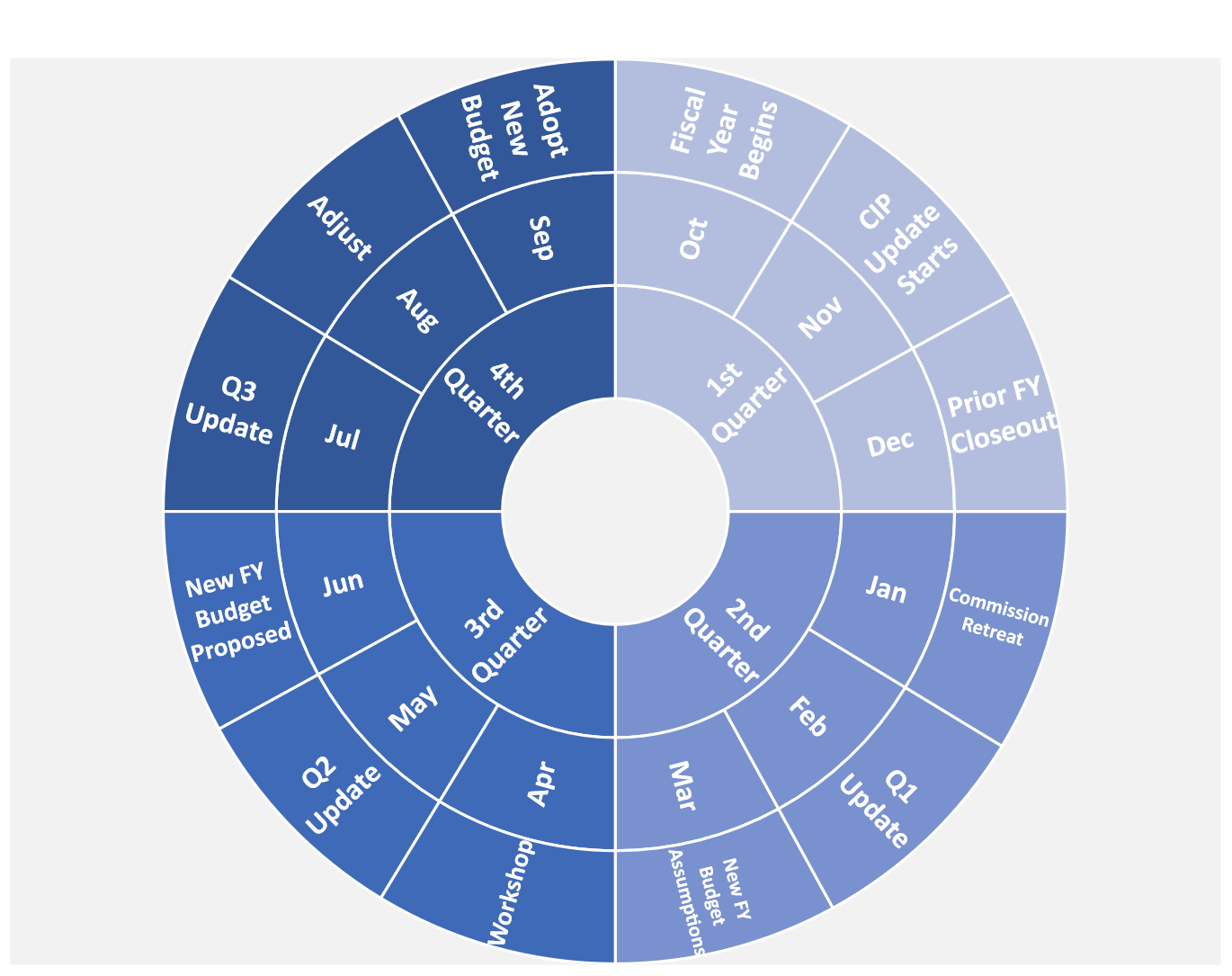
The City holds several budget workshops throughout the year. These serve the dual purpose of updating for the current fiscal year and the next budget cycle. Workshops are less formal city commission meetings that do not include a litany of items for the commissioners to address. Instead, the workshop allows for a focused discussion on the topic.
At the first quarter workshop Resource Management reports on the early status of its funds to the Commission for the current budget cycle. It also presents some initial assumptions to work toward for the next one. This includes proposing an initial millage rate, employee raises, benefits, and other items.
At the second quarter workshop, assumptions are reaffirmed and priorities are addressed. Issues with the current year’s funding can be addressed while taking a stronger look at the upcoming year.
At the third quarter workshop, Resource Management presents a proposed budget for the following fiscal year. These include most of the capital projects, priorities, and changes. Any major issues for the current budget year are also addressed at this workshop.
The City maintains a “hold the line” philosophy when budgeting for departments’ operating costs. Budgets for things such as office supplies or contracts are not increased every year. Without automatic increases in budgets, staff innovate for cost savings annually. Departments evaluate procedures to be more efficient. Maintaining cost levels helps the City to keep its millage rate the same.
Hold the Line counters a classic budgeting issue known as “use it or lose it”. In older budgeting techniques, departments are incentivized to completely spend their budget, and then use their resource depletion as a justification to maintain their budget levels. Sometimes the spending would persuade for even higher budgets the next year. With Hold the Line, Resource Management assures departments that their budget levels are safe. This leads to less spending overall as departments do not spend money merely to defend their allocations.
At the 1st quarter budget workshop, staff present initial assumptions to the City Commission for the next budget year. These include two major items: millage rate and staff pay raises.
For the City to be a leader in public service, it must recruit, train, and retain the best people. The City has a history of regular increases for staff ranging from two to three percent. This accommodates for increases to the cost of living, but the commitment can attract the best employees to the organization. While the recession made an across the board increase for FY21 untenable, other staff bonuses were implemented as discussed earlier.
A diversity of revenue sources blesses the City both through a purposeful strategy and as a matter of history. This allows for the City to keep its millage rate very low compared to other governments, and it has avoided increasing millage for many years.
The public is encouraged to provide input anytime. City Commission meetings, City Commission budget workshops, and commissioner or leadership meetings are all available to citizens. Two statutorily required public hearings on the budget are also held in September each year to solicit public input. Building upon the goal of increased transparency, the City’s OpenGov platform allows citizen review of not only budget information down to the account level, but also actual expenditures and transactions throughout the year.
Departments are responsible for developing their respective budget requests with support from Resource Management. Throughout the year, City Commission budget workshops are held to discuss policy issues and long-term ramifications of budgetary decisions. The City Commission adopts a tentative millage rate for the assessment of ad valorem taxes in early July as required by state statutes. The final budget and the millage rate are adopted by resolution during the month of September, following two statutorily required public hearings.
The City’s budget is appropriated at the fund level. Revenues are budgeted at the fund level only, while Department expense budgets are contained within one or more cost centers. There are currently nearly two hundred cost centers across all department.
Budgetary control is maintained at the department level with Resource Management providing support. In accordance with the city’s budget transfer policy, departments can amend budgets in various ways depending on the type of transfer being considered.
Any budgetary amendment that is within the department’s appropriated budget and within the same fund can be authorized by the City Manager. Transfers between departments that cross funds or increase appropriations are made at the request of the City Manager and must be approved by the City Commission.
Budgetary amendments between divisions and within the same fund may be initiated at the discretion of the department head except for transfers affecting certain categories such as personnel. Requests for amendments to the line item exceptions are reviewed by Financial Management and approved by the City Manager or respective appointed official for transfers affecting the offices of the City Attorney, Inspector General, or City Treasurer-Clerk.
Since the implementation of the PeopleSoft financial system, budgetary control has moved from the line-item level to major budget category. In classic line-item budgeting, departments cannot spend more than a certain amount on very specific categories. This tended to limit flexibility, and governments could not adapt to problems that arose throughout the year. Now, departments may over-expend line items provided there are available balances in the respective major budget category. This allows for greater managerial flexibility. Department heads can respond to citizens’ needs without dense bureaucratic processes.
Five-Year Fund Proformas – Revenues and Expenses by Fund
By clicking on the fund titles below, a five-year proforma of revenues and expenditures will display for each. The proforma includes the budget for the prior year, FY21, the adopted budget for FY22, and projections for the remaining years, FY23 – FY26. The five-year projection is a means of facilitating long-range and financial planning. Below each proforma is a summary of FY22 budget highlights and a link to see an additional view of the fund in OpenGov.

See additional views of FY22 budget in OpenGov
See additional detail of the Five-Year Fund Pro Formas
Estimated revenues and expenditures for FY22-FY26 generally reflect revenue projections and current expenditure levels escalated by a CPI factor and indicate how expected trends applied to current estimates will shape future budget planning.
Budget Highlights
FY22
- Based on taxable value, the property tax revenue for FY22 increased by $1.8 million, or 3.6%. For existing property owners with a homestead exemption, assessed valuations are lower than market value, as the Save Our Homes amendment caps increases for the homesteaded property at 3% regardless of any increase in assessed valuation by the Property Appraiser's office. At $51.7 million, property taxes provide 30% of General Fund Revenues.
- The FY22 budget includes an increase of 4.1% for half-cent sales taxes and state revenue sharing in FY22 and public services taxes by less than 1%. Ongoing pandemic impacts continue to fuel uncertainty in the economy.
- In FY22, the budget includes $5.6 million in American Recovery Plan Act revenue claims.
- FY22 funds two new positions and 41 existing positions converted to permanent, for a total count of 1,042.75 FTEs.
FY23-26
- Future revenue projections are conservative as the City keeps the millage rate low to encourage growth and investment. Other options for revenue generation are minimal and significant revenue sources are sensitive to unforeseen economic impacts.
- Personnel costs escalated by between 4% to 4.2% through FY26.
- Operating costs are escalating by 1.5% overall.
- Transfer estimates vary based in large part on expected changes in existing debt service payments. Estimates do not yet include adjustments for new debt service.
- Estimates for FY23-FY26 do not include estimated increases in the number of positions in the fund—departments review service needs and staff levels during the annual budget development process.
The General Fund for FY22 totals $171.7 million and includes the Tallahassee Police Department, Parks & Recreation, Public Infrastructure (roads and street construction and maintenance), Community Housing and Human Services, and other non-utility services. The fund also contributes to StarMetro and the Consolidated Dispatch Agency, transfers the ad valorem share to the community redevelopment agencies, and transfers funding for capital projects and debt service.

See additional views of FY22 budget in OpenGov
See additional detail of the Five-Year Fund Pro Formas
Estimated revenues and expenditures for FY22-FY26 generally reflect revenue projections and current expenditure levels escalated by a CPI factor and indicate how expected trends applied to current estimates will shape future budget planning.
Budget Highlights
FY22
- The fund is self-sustaining, with fees from increased activities in a given year expected to support the fund over several years of service. In FY22, $654,000 will come from the operating reserve.
- At the current fee structure and projected permit demand, the fund is unlikely to have sufficient reserves for FY23. Staff is conducting an internal fee review to determine activities whose costs exceed their fees. Staff will likely bring recommended fee changes to the City Commission during FY22 for implementation mid-fiscal year or starting in FY23.
FY23-26
- Revenues are projected at an escalator of 1.5% in later years, although revenues tend to vary significantly over time, and demand is difficult to predict.
- Personnel costs escalated by 4% through FY26.
- Operating costs are escalating by 1.5% overall.
- Personnel costs make up the majority of expenditures in the Building Inspection fund.
The Building Inspection Division operates as a separate enterprise fund established to account for all activities related to enforcing the City's building inspection regulations. The fund provides for the enforcement and implementation of the Florida Building Code. The Building Inspection Division is recognized locally as delivering a high level of service, responding to inspection requests, and providing timely plan reviews. During the pandemic, the unit innovated virtual review processes to facilitate construction. The Building Inspection Division does not anticipate any significant increase in service demand in FY22. The fund required transfers from reserves in FY20 and will do so in both FY21 and FY22.

See additional views of FY22 budget in OpenGov
See additional detail of the Five-Year Fund Pro Formas
Estimated revenues and expenditures for FY22-FY26 generally reflect revenue projections and current expenditure levels escalated by a CPI factor and indicate how expected trends applied to current estimates will shape future budget planning.
Budget Highlights
FY22
- In FY22, the Tallahassee Fire Department will continue to provide outstanding services to the community at their current staffing level.
- A 15% increase in rates went into effect on October 1, 2021, which supports annual increases in salary, fleet, and operating costs necessary to provide high-quality fire services.
FY23-26
- The City and County agreed to conduct a joint fire services fee study and present recommendations during the FY24 budget development process for any fee adjustments to be made in FY24 or subsequent years.
- Personnel costs for the upcoming Fire Station 17 are budgeted beginning in FY23.
- Equipment for Fire Station 17 is budgeted over a 5 year period starting in FY23.
- The current collective bargaining agreement between the City and the IAFF will expire at the end of FY23 and a new agreement will affect future year personnel costs.
Established in 1902, the Tallahassee Fire Department (TFD) is a municipal fire department that provides fire suppression and emergency medical services in the City and the unincorporated areas of Leon County, Florida. The department is charged with the responsibility of protecting lives, property and the environment from hazardous conditions that threaten our community. This mission is accomplished through the provision of prevention and protective services specific to the incident need. The Tallahassee Fire Department staff of 300 people includes 285 sworn and 15 non-sworn personnel. Department activities are broadly grouped into Training, Emergency Management, Prevention, Operations (Suppression), Logistics, Public Education, Plans Review and Human Resources and Finance support functions. The Tallahassee Fire Department also provides quality first response non-transport Basic Life Support (BLS) and Advanced Life Support (ALS) services in conjunction with Leon County Emergency Medical Services (EMS). Department services are provided through 16 fire stations and an administrative office in the Public Safety Complex.
In FY20, the City Commission voted to delay the planned rate change for the fire assessment program, that would have taken effect in FY21, due to the financial impacts residents were experiencing from COVID-19. Throughout FY21, the Fire Department focused on reducing expenses to account for the missed revenue. A resolution was adopted by the City Commission to implement rate changes in FY22 and went into effect on October 1, 2021.

See additional views of FY22 budget in OpenGov
See additional detail of the Five-Year Fund Pro Formas
Estimated revenues and expenditures for FY22-FY26 generally reflect revenue projections and current expenditure levels escalated by a CPI factor and indicate how expected trends applied to current estimates will shape future budget planning.
Budget Highlights
FY22
- The Electric Utility develops 10-year sales forecast annually to use in the annual budget process.
- A rate study was completed in 2018 and provides for the assumptions in the pro forma and future obligations.
FY23-26
- The Electric Utility continues to invest in the current electric grid by enhancing funding in tree trimming and systemwide switch inspection and replacement.
- There is also a focus on enhancing transmission reliability and import capability through additional bulk power system interconnections.
- The department continues to look to the future and is working with consultants and key stakeholders to develop and implement the City's Clean Energy Plan.
- Continued funding of pilot EV charging stations program and installation of new stations at key locations throughout the city.
- An Electric Rate Study is planned for the Spring of FY23.
The Electric Utility serves over 128,000 customers in a 221-square mile service territory. It is the fourth largest municipal electric utility in Florida, and the 27th largest of over 2,000 municipal systems in the United States. The utility is comprised of six major divisions: Finance and Administration, Power Delivery, Energy Supply, System Operations, System Compliance, and System Integrated Planning. The Electric Utility develops a 10-year sales forecast annually to use in the annual budget process. This sales forecast is based on a variety of inputs, such as heating and cooling degree days, economic, and population growth, the weather being the most variable driver. As the year progresses, actual sales are used to guide the operational decisions of the utility.
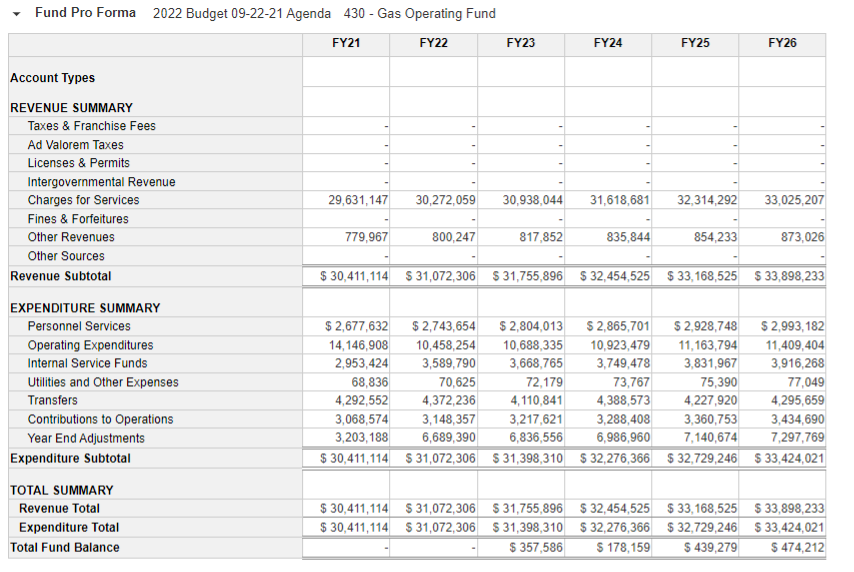
See additional views of FY22 budget in OpenGov
See additional detail of the Five-Year Fund Pro Formas
Estimated revenues and expenditures for FY22-FY26 generally reflect revenue projections and current expenditure levels escalated by a CPI factor and indicate how expected trends applied to current estimates will shape future budget planning.
Budget Highlights
FY22
- A rate study was completed in 2018 and provides for the assumptions in the pro forma and future obligations.
- A new rate study is planned for the Spring of FY22.
FY23-26
- The department continues to look to the future and is working with consultants and key stakeholders to develop and implement the City's Clean Energy Plan.
- Enhancement of Gas Leak Detection and Repair (LDAR) Program.
- Further implementation of the Utility's Methane Reduction Program.
The City of Tallahassee's Natural Gas Utility has provided clean, safe, economical and reliable natural gas to residents and businesses in a growing service area for over 60 years. The utility safely provides natural gas energy through 965 miles of underground gas mains that serve over 34,000 customers in the Leon, Gadsden, and Wakulla County areas. The highly trained staff works to ensure the integrity and dependability of the distribution system, and to assist customers with energy conservation and cost savings through natural gas use. A rate study was completedin 2018and has provided for the assumptions detailed in the pro forma as well as future obligations.
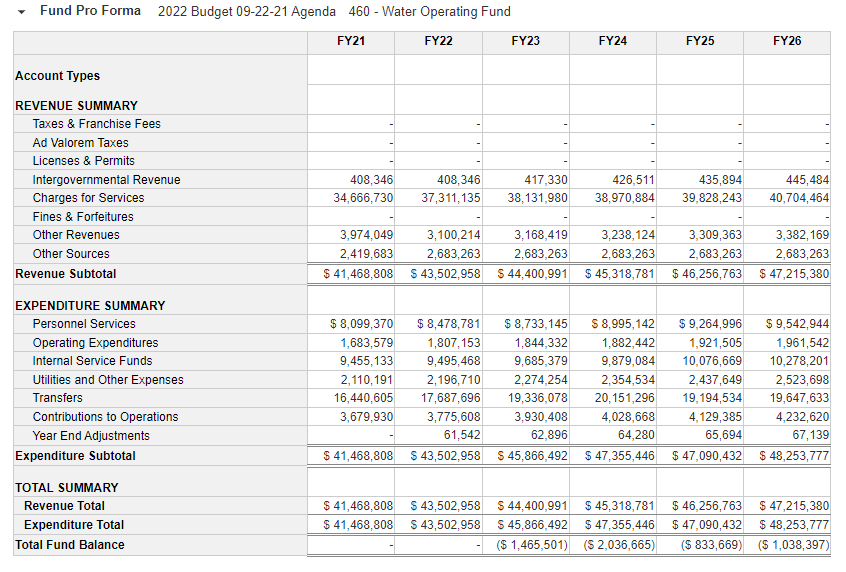
See additional views of FY22 budget in OpenGov
See additional detail of the Five-Year Fund Pro Formas
Estimated revenues and expenditures for FY22-FY26 generally reflect revenue projections and current expenditure levels escalated by a CPI factor and indicate how expected trends applied to current estimates will shape future budget planning.
Budget Highlights
FY22
- Following an FY21 rate study, water rates were increased by CPI set at 2.6% on October 1st, 2021, along with a proposed increase of 4.6% effective January 1st, 2022. Total customer impact on average residential utility bill (5,000 gallons) equates to $1.31 per month.
- Operating expenditures are estimated conservatively high, with inflation set at 4.1%, and are based on the rising material costs resulting from COVID-19.
- Redistribution of the Survey and Construction Inspections division costs, fully funded in Sewer, were split with Water and reflected an approximate $800 thousand increase expense to their inter-fund transfers.
- Capitalized Overhead revenue is reduced by $1 million based on historical trends for direct labor charges to projects.
FY23-26
- Assumptions for rate revenues include modest customer growth and CPI set at 4.1% in FY23 and 2.5% thereafter.
- Operating expenses are estimated at an inflation rate of 2.5% per year and include plans for future debt in FY2023
- Commitment to capital investments includes a future borrowing FY22-23 and a 4.4% average increase per year in the RR&I transfer through FY2025.

See additional views of FY22 budget in OpenGov
See additional detail of the Five-Year Fund Pro Formas
Estimated revenues and expenditures for FY22-FY26 generally reflect revenue projections and current expenditure levels escalated by a CPI factor and indicate how expected trends applied to current estimates will shape future budget planning.
Budget Highlights
FY22
- Following an FY21 rate study, sewer rates were increased by CPI set at 2.6% on October 1st, 2021, and no changes in January 2022. Total customer impact on average residential utility bill (5,000 gallons) equates to $1.38 per month.
- Operating expenditures are estimated conservatively high, with inflation set at 4.1%, and are based on the rising material costs resulting from COVID-19.
- Redistribution of the Survey and Construction Inspections costs split with the Water fund resulted in offsetting revenue that increased Sewer's transfer from the Water by approximately $800 thousand.
- The transfer from the operating reserve fund, previously budgeted at $3.8 million, was removed in FY22 as rate revenues are expected to sustain operations.
FY23-26
- Assumptions for rate revenues include modest customer growth and CPI set at 4.1% in FY23 and 2.5% thereafter.
- Operating expenses are estimated at an inflation rate of 2.5% per year and include plans for future debt in FY2023.
- Commitment to capital investments includes a future borrowing in FY22-23 and a 3.7% average increase per year in the RR&I transfer through FY2025.

See additional views of FY22 budget in OpenGov
See additional detail of the Five-Year Fund Pro Formas
Estimated revenues and expenditures for FY22-FY26 generally reflect revenue projections and current expenditure levels escalated by a CPI factor and indicate how expected trends applied to current estimates will shape future budget planning.
Budget Highlights
FY22
- Total revenues have increased over the past two years and include a $2.2 million increase in revenue this FY. The increase is due in large part to post-pandemic and passengers returning. In October 2021 alone, passenger traffic saw a 126% increase compared to October 2020.
- The airport continues to receive considerable grant funding for capital projects.
- Expenses are budgeted to increase by $2.2 million from FY21 to FY22. The most significant changes are from increases in Personnel Services and Operating Expenditures due to a rise in post-pandemic passenger traffic.
- FTE employees have stayed constant at 54 since FY19
- Major Capital projects are ongoing at the airport, including the International Passenger Processing Facility, Parking Facility improvements, and Taxiway Rehabilitation.
FY23-26
- Planning for future taxiway rehabilitation projects, along with additional facility capital improvements
- The Bipartisan Infrastructure Bill estimates the airport to receive roughly $16.1 million over the next five years.

See additional views of FY22 budget in OpenGov
See additional detail of the Five-Year Fund Pro Formas
Estimated revenues and expenditures for FY22-FY26 generally reflect revenue projections and current expenditure levels escalated by a CPI factor and indicate how expected trends applied to current estimates will shape future budget planning.
Budget Highlights
FY22
- The FY22 budget totals $19.6 million, which is $2.1 million, or 11%, higher than FY21. This change is due primarily to an increase in projected revenue from grants and the FSU bus contract on the revenue side and increased personnel and fuel costs for fixed- route service on the expense side.
- Projected grant fund revenue of $6.6 million is an increase from last year's $3.7 million budget due to the availability of ARPA funds.
- The FSU bus contract revenue projection is back to the pre-pandemic level of $3.7 million as the school has resumed full on-campus activities.
- With pandemic-related revenue loss to StarMetro and the General Fund, the General Fund's contribution to StarMetro decreased to $3.8 million from the prior year's budget of $5.8 million. ARPA funds are being used to supplement StarMetro's revenue.
- There is an addition of 7.00 FTEs, increasing from 139 in FY21 to 146 in FY22 due to OPS employees being converted to FTEs. Additionally, some temporary employees will move to OPS as part of the department's new career progression plan.
FY23-26
- Future budget projections assume a steady annual increase in ridership and fare cash and a steady decrease in Gas Tax revenue.
- Expenses for both fixed route and Dial-A-Ride services are expected to increase each year due to expected salary increases. The cost of fuel is a factor but is challenging to forecast.
- The General Fund contribution will remain around the FY22 level ($3.8 million) through ARPA funding's eligible use deadline of FY24 and then increase towards prior years' levels ($5.8 million).
- Continue to leverage grant funds and work with Fleet Management to purchase electric buses and convert all vehicles to electric by 2035.
- For capital projects and infrastructure, the department expects to complete the South City Transit Center and continue to enhance bus stops with their Blueprint allocation ($612,500 annually).
The City has operated StarMetro, a public transit system, since December 1973. StarMetro provides fixed route and special transportation services under the Americans with Disabilities Act (ADA) provisions and serves as the Community Transportation Coordinator (CTC) for Leon County. Public transportation services include weekday cross-town routes as well as university routes. StarMetro also provides individually scheduled per request (para-transit) transportation to senior, disabled and low-income customers in Tallahassee and Leon County.
StarMetro heavily relies on personnel to accomplish its mission. StarMetro's primary goal is to meet the community's service needs within budgetary constraints by monitoring on-time performance and ridership levels monthly and quarterly, daily and weekly staffing levels.
StarMetro's vehicles and facilities comply with rules and regulations contained in the State of Florida Uniform Traffic Control Laws, Florida Administrative Code, Federal Motor Vehicle Safety Standards, and the Federal Transit Administration Policies and Procedures.
StarMetro regularly uses grant funds for capital projects and operating. A combination of CARES Act, American Rescue Plan, Urbanized Area Formula Grants, and FL Department of Transportation (FDOT) grants have been used in recent years and will be used in FY22 to support operations. Assumptions for significant revenue sources for StarMetro in FY22 operating budget include:
- Gas tax revenue of $3.0 million
- Revenue from the FSU contract is returning to pre-COVID levels as the university plans to be at full service and capacity starting in the fall of 2021.
- American Rescue Plan funding of $4.3 million
- Federal Transit Authority formula grant 5307 funding of $1.1 million
StarMetro routinely evaluates how they can offset higher overtime personnel expenses by utilizing temporary employees and capturing salary savings. Additionally, they identify ways to boost hiring and retaining current staff (a common problem public transportation agencies face) within the budget.

See additional views of FY22 budget in OpenGov
See additional detail of the Five-Year Fund Pro Formas
Estimated revenues and expenditures for FY22-FY26 generally reflect revenue projections and current expenditure levels escalated by a CPI factor and indicate how expected trends applied to current estimates will shape future budget planning.
Budget Highlights
FY22
- The fund is self-sustaining, with monthly service charges paying for services.
- Solid Waste rates are reviewed every three to four years to ensure cost recovery over the planning period.
FY23-26
- Based on contractual provisions, revenues and expenditures are estimated using a 2.2% CPI factor from FY23 to FY26.
- The City will complete a rate study for the Solid Waste Fund in FY23.
As part of the Community Beautification and Waste Management Department, the Solid Waste Fund provides removal and disposal of garbage, bulky items, yard waste, and recycling and recycling services for 50,000 residential and 15,000 commercial customers within the city limits.

See additional views of FY22 budget in OpenGov
See additional detail of the Five-Year Fund Pro Formas
Estimated revenues and expenditures for FY22-FY26 generally reflect revenue projections and current expenditure levels escalated by a CPI factor and indicate how expected trends applied to current estimates will shape future budget planning.
Budget Highlights
FY22
- Operating revenues and expenses were adjusted by CPI at 1.4% for FY22 and included a $3 million transfer to RR&I.
- Personnel cost increased by 7.3% over FY21 and was partially mitigated by the $320 thousand budget reduction in the internal service funds.
- There are no significant changes to the funds operating expenses as they are continually looking for savings to produce a year-end transfer to their RR&I fund for capital improvements.
FY23-26
- Revenues are held stable with the current CPI of 1.4% and consider minimal customer growth.
- Operating expenses are also estimated at the current inflation rate of 1.4% per year. A fee study is contemplated in the next few years to assess the long-term sustainability of the utility.
- Emphasis on maximizing the RR&I transfer through reducing operating expenses will continue to be monitored each year.

See additional views of FY22 budget in OpenGov
See additional detail of the Five-Year Fund Pro Formas
Estimated revenues and expenditures for FY22-FY26 generally reflect revenue projections and current expenditure levels escalated by a CPI factor and indicate how expected trends applied to current estimates will shape future budget planning.
Budget Highlights
FY22
- Revenues are estimated to be higher in FY22, primarily due to a continued increase in tee times used and the course not being closed for two months like in FY21. The course closure was due to the ongoing pandemic.
- Total expenditures are also budgeted to be slightly higher in FY22 compared to FY21. Again, this is primarily due to the course opening an additional two months in FY22 than in FY21.
- FTE has remained consistent over the past three fiscal years.
- Golf course management also plans to resurface the parking lot in FY22.
FY23-26
- Steady revenue growth is expected over the next four years.
- At this time, there are no major Capital Projects planned for the golf courses.
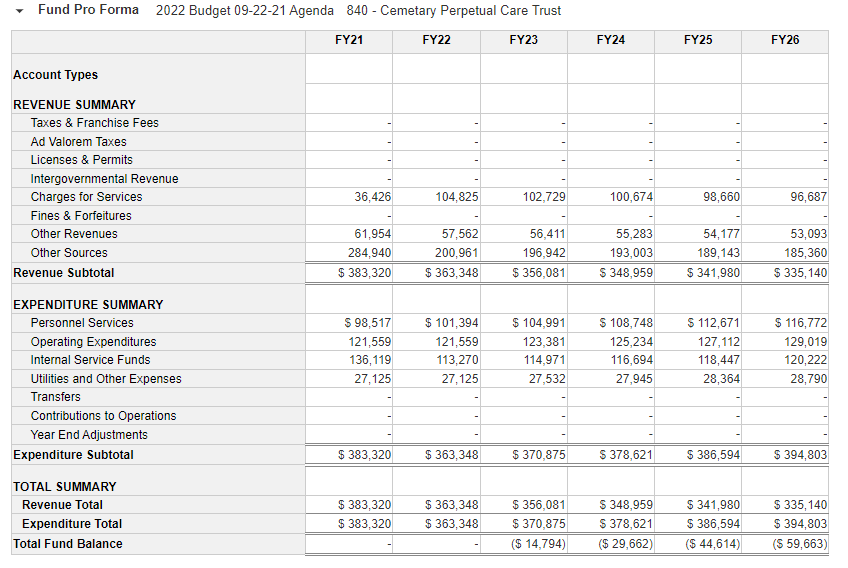
See additional detail of the Five-Year Fund Pro Formas
Estimated revenues and expenditures for FY22-FY26 generally reflect revenue projections and current expenditure levels escalated by a CPI factor and indicate how expected trends applied to current estimates will shape future budget planning.
Budget Highlights
FY22
- Operating expenses maintain the hold the line budget with zero inflation applied.
- Lot sales are budgeted at triple the amount of FY21 due to spaces being made available through a new buyback program. The City purchases several unused and has resulted in an additional 750 spaces available for sale.
- There are no significant changes to the funds budgeted operating expenses as they are continually looking for savings to extend the life of the PCTF.
FY23-26
- The latest projections for the PCTF to maintain a position balance are through 2031. This includes conservative projections for interest earnings on the current balance of $3.1 million, and that lot sales will average approximately 100 spaces sold per year.
- Operating expenses assume inflation at 1.5% per year but have historically been under-budgeted, with expenses growing faster than CPI.
- In FY21, the fund purchased new land for future expansion, increasing the available spaces for sale. This is not currently calculated in the long-term plan and should increase the longevity of the fund.
3.1 Financial Schedules
Return to Top
This section contains links to the OpenGov transparency portal that the City of Tallahassee uses to share financial and budgetary information. The strength of the platform lies in the power of the viewer to see the budget from any angle. Select the links below as starting points.
3.2 Fund and Reserve Balances
Return to Top
Click here for the Capital Fund Balance Report
Click here for the Schedule of Reserves
| Fund |
FY21 Amended
Budget |
FY21 Actual
Revenue |
FY21 Actual
Expense |
FY21 Actual
Variance |
Year-End Closing Action |
| General |
$163,678,101 |
$163,678,100 |
$159,550,957 |
$ 4,827,143 |
Transfer $4.5 million to capital projects per the ARPA Funding Plan; transfer balance of surplus to the Deficiencies Fund. |
Building
Inspections |
4,255,943 |
3,563,306 |
4,194,012 |
(630,706) |
Use of Building Code Reserves Fund 121 per State Law. |
| Fire |
46,096,358 |
47,471,098 |
47,599,710 |
(128,612) |
Transfer from Deficiencies Fund to Fire Fund ($128,612) and to Fire Reserve Fund ($465,201). |
| Electric |
288,503,827 |
273,158,180 |
274,699,954 |
(1,541,775) |
Budgeted transfer from reserves was $4.5 million, actual transfer $1.5 million. |
| Gas |
30,498,009 |
27,259,556 |
23,658,078 |
3,601,478 |
Transfer to RR&I per policy. |
| Water |
41,579,597 |
40,788,541 |
41,227,821 |
(439,280) |
Transfer from operating reserves to offset reduced retail sales revenue. |
| Sewer |
76,288,147 |
71,993,368 |
72,773,133 |
(779,765) |
Transfer from operating reserves to offset reduced residential sales revenue. |
| Aviation |
12,428,526 |
13,017,007 |
10,880,369 |
2,136,638 |
Transfer to RR&I and airline revenue sharing per policy. |
| StarMetro |
17,833,992 |
11,430,081 |
11,430,081 |
- |
No action needed. |
| Solid Waste |
29,816,110 |
30,686,490 |
30,497,877 |
188,613 |
Transfer to operating reserve per policy. |
| Stormwater |
19,106,941 |
20,331,290 |
18,492,977 |
1,838,313 |
Transfer to RR&I to fund future investment in infrastructure per policy. |
| Golf |
994,262 |
1,144,719 |
1,009,038 |
135,681 |
Transfer to operating reserve per policy. |
| Cemetery |
385,355 |
195,034 |
409,712 |
(214,678) |
Transfer from Perpetual Care Trust Fund per policy. |
General Fund
The General Fund for FY21 is balanced at $163,678,100. General Fund revenues for the FY21 budget were estimated conservatively, understanding that many of the major revenues sources such as sales taxes, revenue sharing, charges for services, licenses and permitting are sensitive to public confidence in resuming pre-COVID-19 activities. At the time of budget development, the resulting economic uncertainty and related increase in unemployment pointed toward continued revenue losses for many of the General Fund’s key revenue sources.
Despite these indicators, the overall FY21 General Fund revenues exceeded estimates. Combined Ad Valorem Property Tax, State of Florida Revenue Sharing and Florida Half-Cent Sales Tax revenues exceeded budget by a combined $3.7 million. Environmental Permitting revenues exceeded budgeted amount by over $800,000 due to changes in fee structures on impacted land. Conversely, some revenues continue to be negatively affected by COVID-19, most notably recreations fees, which were nearly $1 million less than budgeted.
Although actual revenues exceeded budgeted revenues, it is important to note that collections would have been greater had the growth trends from FY19 continued. As such, the City continues, and will continue, to experience revenue losses due to COVID-19 and will rely on ARPA funding to offset these losses.
Ongoing impacts on the economy and service needs due to COVID-19 will require continued monitoring of revenues and expenditures in FY22 to identify deviations from estimates early on and to continue to focus on essential services and efficiencies to end in a balanced position next year. It will be critical to balance the use of ARPA funds for non-recurring expenditures, such as capital investment, with the growth in revenues to pre-COVID-19 levels to support recurring operating costs.
General Fund – Reserve
The City’s Deficiencies Fund reserve balance is currently below the designated policy level. The current policy calls for a minimum reserve of two months of general government operating expenses and is in line with best practices for municipal governments. Based on the policy, the FY21 year-end target balance for the Deficiencies Fund is $26,965,720. However, the actual year-end balance for FY21 is $20,823,572.
The current balance reflects the recommended FY21 year-end actions, including a transfer of $252,323 from the General Fund due to a year-end surplus; a transfer to the Fire Operating Fund of $128,612; and a transfer of $465,201 to the Fire Operating Reserve Fund. The City anticipates that future real estate sales and federal reimbursements for past storms and COVID-19 response will help to restore the Deficiencies Fund to policy level by FY23. For FY22, the target level has increased to $28.6 million.
StarMetro
The StarMetro Fund for FY21 is balanced at $11,430,081. The department utilized grant funds to balance, including $2.43 million in salaries expensed to federal and state grants including ARPA, CARES, Coronavirus Response and Relief Supplemental Appropriations Act (CRRSAA), and urbanized formula grants. Another $1.1 million of operating costs were charged to federal urbanized formula grants. Due to the increased availability of grant funding during the year, the FY21 General Fund transfer to StarMetro was $3.84 million, $2.0 million below budget.
Revenue from the FSU bus service contract recovered partially after a significant decrease in FY20 due to COVID-19. Down from $3.72 million in FY19 to $2.96 million in FY20, the contract brought in $3.32 million in FY21. Gas Tax proceeds followed a similar pattern, decreasing from $3.11 in FY19 to $2.66 million for FY20, followed by an increase to $2.74 million in FY21.
Building Inspection
The Building Inspection Fund for FY21 is balanced at $4,194,012 with the use of $630,706 in operating reserves. The Building Inspection Fund’s operating reserve balance was $1.76 million before the $630,706 transfer, leaving approximately $1.15 million in reserves for future use.
As a self-balancing fund, reserves are maintained in the Building Inspection Fund to provide for the variability of building activity. While construction will likely increase in FY22 due to the recovering economy, fees will be reviewed to ensure that the fund has a reasonable margin to fund operations and a recommendation will be brought to the Commission at a later date.
Fire
The Fire Operating Fund ended FY21 with a deficit of $128,612. In addition to the deficit in the operating fund, the Fire Operating Reserve has been in a deficit position since the close of FY20. An additional $465,201 was needed to balance this fund. A total of $593,813 in General Fund reserves were transferred to balance both funds.
In FY20, the City Commission voted to delay the planned rate change for the fire assessment program, that would have taken effect in FY21, due to the financial impacts residents were experiencing from COVID-19. Throughout FY21, the Fire
Department focused on reducing expenses to account for the missed revenue. A resolution was adopted by the City Commission to implement rate changes in FY22 and went into effect on October 1, 2021.
Electric Utility
The Electric Fund for FY21 is balance at $274,699,954 with a transfer of $1.54 million from the Electric Operating Reserves. Monitoring the impacts of COVID-19 on Electric Utility operations continued throughout FY21. Overall, the impacts to sales continued much like FY20, with increased residential sales and decreased commercial sales. This resulted in retail electric sales being 3.8% below forecast, while an increase in wholesale sales partially offset the retail sales shortfall. Bad debt expenses, such as uncollected residential and commercial billings, exceeded budget due to the ongoing economic effects of COVID-19.
Gas Utility
The Gas Fund for FY21 is balanced at $27,259,556 with a transfer of $3.6 million to the Gas RR&I fund. Monitoring the impacts of COVID-19 on Gas Utility operations continued throughout FY21. Overall, the impacts to sales was moderate, with retail gas sales 5% above forecast. The Gas Utility experienced strong customer growth of 3% this fiscal year in the residential segment, while maintaining a strong customer service rating of 4.7 out of 5.0 from its customers. Bad debt expenses exceeded budget due to the ongoing economic effects of COVID-19.
Water Fund
The Water Fund for FY21 is balanced at $41,227,821 with a transfer of $439,280 from the Water Operating Reserve. Despite expenditure savings in operating and utility costs, water's retail sales were down 1.8% over the prior year and, combined with historically under collected miscellaneous revenues, resulted in a fiscal year deficit. Operating reserve funds are established to account for variability and ensure the utility can meet its General Fund contribution. The rate study completed in FY21 anticipated budget assumptions to balance revenue requirements with a multi-year plan and will seek to monitor expenses and find efficiencies to replenish reserves and to stay within the parameters of the rate study.
Sewer Fund
The Sewer Fund for FY21 is balanced at $72,773,133 with a transfer of $779,765 from the Sewer Operating Reserve. Sewer's residential sales followed water consumption trends and were down 2.3% over the prior year. Various expenditure savings of approximately $3.5 million offset this, resulting in the reduced budgeted transfer from the operating reserve. The rate study completed in FY21 anticipated budget assumptions to balance revenue requirements with a multi-year plan and will seek to monitor expenses and find efficiencies to replenish reserves and to stay within the parameters of the rate study.
Stormwater
The Stormwater Fund for FY21 is balanced at $18,492,977 with a transfer of $1.83 million to the capital Renewal, Replacement, & Improvement (RR&I). Revenue collections for stormwater fees exceeded forecast by 6%, which were based on conservative projections that assumed no customer growth in FY21. This is combined with savings in operating expenses from delayed equipment purchases and reduced spending in contractual services.
Aviation
The Aviation Fund is balanced at $13,017,007. The department received $3.2 million in Federal Stimulus funds that were used to offset decreased revenues in FY21 attributed primarily to the decrease in passenger traffic. Surplus revenue of $2.1 million were transferred to Airport RR&I fund in accordance with the Airline Use and Lease Agreements implemented in FY17.
Solid Waste Fund
The Solid Waste Fund is balanced at $30,686,490. FY21 resulted in revenues in excess of expenditures of $188,613 in the Solid Waste Fund, primarily due to $1.1 million in revenue above that budgeted for Charges for Service, which was largely offset by associated operating costs. The additional service demand was due to customers spending more time at home and generating more household waste for pickup and disposal. The surplus will be transferred to the operating reserve and will offset future increases in recycling costs.
Golf
The Golf Fund finished with a surplus of $135,681 before the year-end adjustment. These funds will be transferred to RR&I for future capital projects, balancing the fund at $1,144,588.
Rounds played and membership fees remain the drivers of fund revenue, while the driving range has had increased impact. Memberships held steady from the end of FY20, while rounds played in FY21 increased by 27% over FY20, pacing a 37% increase in overall fund revenue. Driving range fees nearly doubled to $111,507 from $55,285.
Cemetery
Revenues and expenditures for the Cemetery Fund are balanced at year-end, at $409,712. Staff is continuing to monitor the drawdown of the Perpetual Care Trust Fund (PCTF) by managing maintenance costs, evaluating current inventory and engaging in a buyback program to provide additional spaces to replenish the trust fund. Subject to the assumption for increases from future sales of graves spaces, it is projected that the PCTF is funded through FY31 while maintaining current operations.
3.3 Revenues
Return to Top
The City has hundreds of different sources of revenue, but there are 27 specific types that account for over 80% of the organizations proceeds. The Revenue Analysis describes them, explains how they are budgeted, and reviews the current trends.
Click here to review the Revenue Analysis.
3.4 Long-range Financial Plans
Return to Top
This section directly connects the financial sections of the strategic plan and addresses other financial issues with a long-term outlook.
Click the objectives or initiatives below to monitor these plans progress.
The City of Tallahassee is committed to providing a living wage to its employees. The City Commission approved a minimum living wage of $12 per hour in FY18 for all full-time employees. The City Commission expanded the application in FY19 to include hourly employees who work more than 30 hours a week on average and are eligible for health care coverage.
Over 60 percent of Florida voters approved increases to the minimum wage to begin in 2021. The hourly minimum wage will become $10 per hour with an annual increase of $1 until it reaches $15 in 2026. In addition to this change, the cost of living has increased. The Massachusetts Institute of Technology’s Living Wage Calculator indicates that a single adult’s living wage requirement is $13.89 per hour in Tallahassee, rising from $12 per hour just a few years ago.
Recognizing the state law’s future impacts and the need to account for cost-of-living increases, the City Commission approved a minimum living wage of $15 per hour for all permanent and Other Personnel Staff (OPS) employees for the FY22 budget.
As state law, market conditions, and cost of living change, the City will adapt its approach to maintaining a high standard of living for its employees.
Prior to FY21, the City paid an average of 70% of health care costs, with the employee paying 30%. At the time, the City planned on transitioning to an 80%/20% split by FY23. A step was taken in FY21 when the employer-employee split-adjusted to an average of 75%/25%. The City then opted to move to 80%/20% in FY22, one year earlier than initially planned. Implementing this change provides average annual savings to employees of $500 overall three health plans, with annual savings of $976 for those with family coverage.
While the City offers generous benefits packages, the State of Florida, a primary employer in the area, covers nearly 98% of the cost of health insurance for some employees. This can make it difficult for the City to recruit the best staff as the cost of insurance can be a significant deterrent for potential hires. Increasing the employer (City) share of health insurance benefits over the next few years will alleviate this issue.
3.5 Internal Service Funds
Return to Top
Internal service funds account for the financing of goods and services provided by one department or unit to other departments or units of the government on a cost-reimbursement basis. Each operating fund records an expense for the allocation. Some internal service funds receive fee income or other revenues to offset their costs and reduce the allocation. All internal service fund and indirect cost allocations are updated each year to reflect updated statistical allocation formula data.
View a brief description of each internal service fund and the basis of cost allocations.
View a detailed view of the internal service fund allocation.
4.1 Capital Improvement Plan and Budget Process
Return to Top
Capital Improvement Plan
Fixed assets have a value of $750 or more and a useful lifespan of more than one year. Capital expenditures are related to the building, purchase, or maintenance of those fixed assets that belong to the City of Tallahassee.
The City uses capital budgeting to ensure the proper maintenance and investment in its infrastructure. The development of the capital improvement plan (CIP) is continuous as departmental project managers evaluate the timeline of each project and maximize the use of available funding throughout each year. Departments review their capital plans in the first quarter of the fiscal year. They adjust their plans as needed throughout the year prior to the City Commission passing the next year’s budget.
Department staff, Resource Management, and the Treasurer-Clerk’s office collaborate on funding for capital needs using a combination of cash and debt as appropriate within policy and credit rating standards.
In a typical year, Resource Management presents an initial capital budget to the Commission in the 2nd quarter to collect both community and elected official feedback. For Fiscal Year 2022 planning, these meetings were combined with others due to the virtual format implemented for social distancing.
Impact of Capital Investments on Operating Budget
Operating budgets supply the funding for capital expenditures. Multi-year capital financing plans are implemented to spread the cost of these projects over their useful life, financing them with annual transfers for debt service on capital or utility bonds as well as transfers to Repair, Replace and Improve (RR&I) funds. To see department budgeted RR&I transfers, click here. This allows operating funds to adjust for the cost of capital financing incrementally from year to year, matching the flow of revenues to capital expenses.
Operating impacts can come in various forms from changes in staffing, operation and maintenance cost, as well as borrowing capacity for future financing. To see project-specific operating costs, click here.
Beginning fiscal year 2022, Resource Management has worked with departments to estimate specific dollar impacts for projects in the capital plan and report the information in OpenGov.
4.2 Highlighted Capital Projects
Return to Top
Betton Hills Area Improvements

A number of projects to improve traffic flow, pedestrian safety, water supply, and drainage in the Betton Hills area.
See more...
Victory Garden Drive Sidewalk Improvements

The Victory Garden Drive Sidewalk Improvements project will provide a new sidewalk along Victory Garden Drive from Apalachee Parkway to Park Avenue.
See more...
Country Club Drive Water Main Replacements

The City of Tallahassee is planning a utility improvement project near Country Club Drive to replace the existing potable water infrastructure. Replacing the aging infrastructure will reduce service interruptions caused by maintenance and repair activities. This will allow the City to continue providing reliable, quality water service for area residents for years to come.
See more...
Redevelopment of Northwood Centre Parcel

The Northwood Center site is being prepared for redevelopment by the City of Tallahassee. Sitting on approximately 29.5 acres, the site is bordered by North Monroe Street, North Martin Luther King Jr. Boulevard and Tharpe Street. A key component within this redevelopment is construction of the new headquarters facility for the Tallahassee Police Department. Additionally, the site presents opportunities for new green space, community amenities and other economic development projects.
See more...
Zillah PASS Project

The Zillah Street Pedestrian and Street Safety (PASS) project includes plans to enclose the open ditch running alongside the roadway. Improvements to pedestrian connectivity are also a significant aspect of the project. Included are plans to build sidewalk and a multi-use trail, along with making improvements to the pedestrian crossing conditions in the area. The project is currently in the design phase and resident feedback will be collected during this time. Construction is anticipated to begin in summer of 2021.
See more...
Market District Multi-Purpose Stormwater Project

To keep pace with growth and improve the quality of stormwater flowing to Lake Jackson, upgrades to the area's stormwater system are necessary. This infrastructure work creates an opportunity to enhance Sense of Place efforts already underway in the Market District. Here you'll find current concept plans, information and a feedback form. Your input will help shape this project and the future of our community..
See more...
Click here to view the new facility in the Capital Improvement Plan.
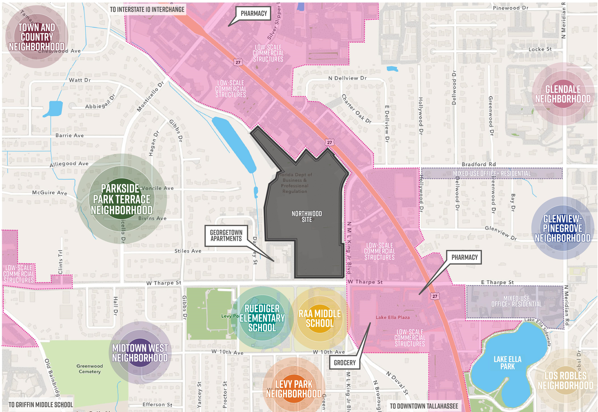
In 12 years, the original structure of Tallahassee Police Department Headquarters will be 100 years old. Due to its age, the building maintenance costs are expected to increase. The department estimates that there are more than $3.4 million improvements needed in the next five years.
A new public safety facility will contain the space needed to serve as a community hub for department sponsored events. A larger facility will provide much-needed training space that could also be utilized to host ongoing community programs like Citizen’s Police Academy, Youth Citizen’s Police Academy, Drug Education for Youth, and Rape Aggression Defense courses for women and children.
In accordance with the site selection process outlined and approved at the March 6, 2019, City Commission meeting, the City solicited and received a total of 68 site proposals from citizens, realtors and property owners. The initial list of 68 sites was evaluated and given a preliminary score based on the criteria approved by the Commission. Eventually, the City selected the Northwood Centre as the home for the future public safety complex.
Within the capital improvement plan, the public safety complex has $2 million for the initial work in 2021, with $33.7 million in 2022 for the bulk of the construction, and $6.7 million in 2023 to finish the complex.
Phase I (18-24 months; Complete)
- Community Outreach and Nominations of Potential Sites
- Commission Approval of Site Evaluation Criteria
- Site Analysis and Selection
- Competitive Selection of Architect and Contractor
Phase II (8-10 months; In Progress)
- Environmental Assessment and Hazardous Materials Abatement
- Demolition of former Northwood Mall Complex
- Community Meetings
- Draft Conceptual Designs
- MWSBE and Disadvantaged Workers Recruitment
Phase III (12-14 months)
- Community Outreach
- Civil Site Work
- Complete Construction Design and Pre-Construction Services
- Complete Master Planning
Phase IV (18-24 months)
- Construction
- TPD Coordination and Move-In
Click here to view the new Senior Center in the Capital Improvement Plan.
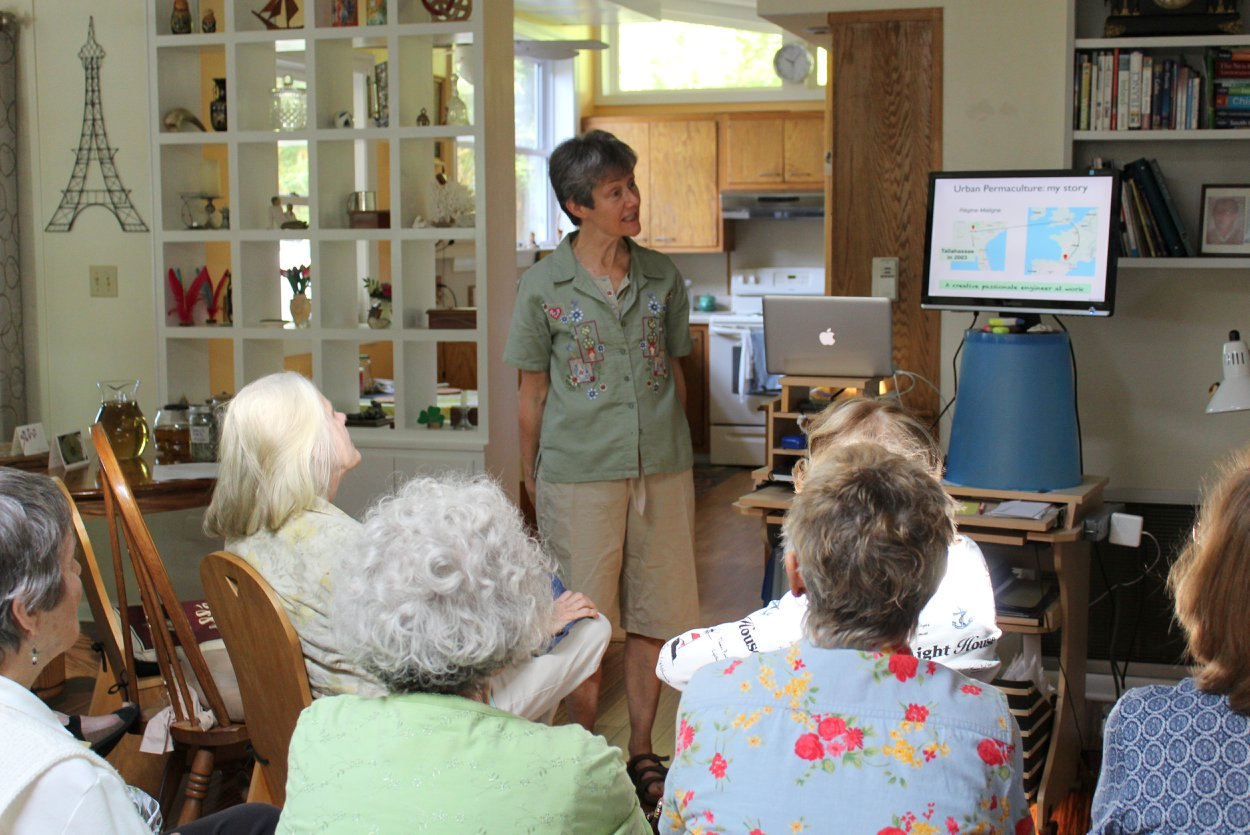
Plans for a Northeast Senior Center located in the Canopy development at Welaunee are underway. The new Senior Center addresses growth as Tallahassee attracts retirees. The Center will enhance the quality of life for the community’s seniors by accommodating their lifelong learning, wellness and fitness, arts and crafts, music, and games.
Multipurpose spaces will foster vibrant social lives and life enrichment by hosting meetings, games, conferences, workshops, and concerts. Seniors will interact in comfortable cafes and coffee shops. Various athletic events will be held at the multisport gymnasium.
A total of $17 million is planned from the 2020 Sales Tax extension for the construction of this new facility. Through its partnership with the Tallahassee Senior Center Foundation, the City has developed a successful model at the current Senior Center. City staff will work closely with the Foundation to ensure similar success for the new facility.
Click here to view the new Lake Bradford Fire Station in the Capital Improvement Plan
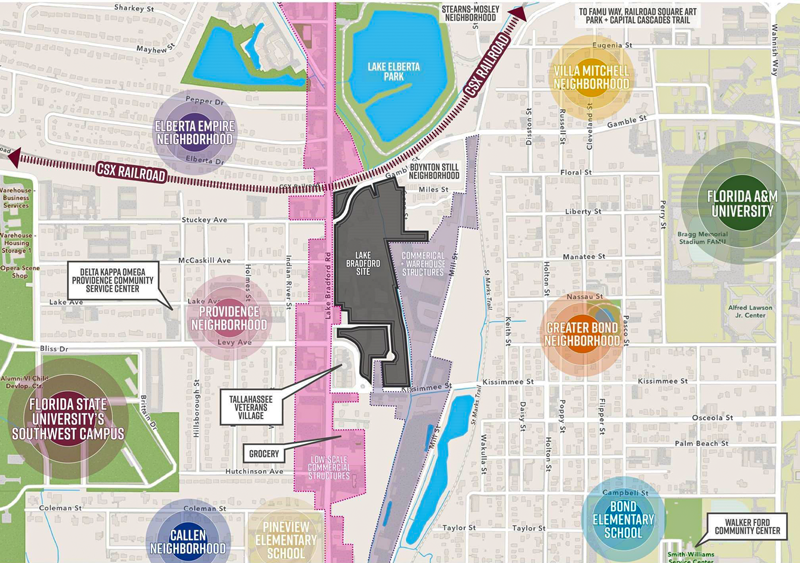
The City Commission directed staff to initiate design and master planning services for the new Fire Station 17 and Community Resilience Center at the former Lake Bradford Road Wastewater Treatment Facility. This new facility will enhance response times for fire and other emergency services on the City’s southside and aligns with the City’s Strategic Plan, including but not limited to Objective 5D-1 which seeks to increase the percentage of the City covered by Advanced Life Support (ALS) fire stations.
Facilities for other public services and amenities, such as a TEMPO Resource Center, Community-Oriented Policing Squad (COPPS), Community Outreach and Neighborhood Services, Sustainability, Resilience and Code Enforcement, as well as public gathering space, are also planned as part of the overall development of the Lake Bradford Road site. Including these amenities around a new fire facility would complement the neighborhood improvement and placemaking efforts of citizen groups in the Bond, Callen, Providence, and other neighborhoods.

The City’s Neighborhood First planning process provides for broad-based community participation involving neighborhood residents and community stakeholders. It is a strategic planning initiative that is offered to neighborhoods participating in the Neighborhood Public Safety Initiative to address their top priorities. Projects include façade and street improvements, park enhancements, development of Community Redevelopment Agency/City-owned lots, historic preservation, and more, consistent with neighborhood priorities and outlined in each neighborhood’s plan. The FY22-FY26 capital improvement plan update includes $2 million a year to support neighborhood plans in the City.
4.3 Capital Funding Sources
Return to Top
The City’s debt policy identifies debt-financing goals the City seeks to achieve. It provides targets rather than requirements and applies to all debt issued by the City of Tallahassee. The policy also addresses debt structure, debt issuance, debt refunding, debt targets, and other topics.
Bond Proceeds are funds received through bond revenue to pay for water, wastewater, electric, gas, and general government capital infrastructure projects. Bond proceeds in this year’s capital improvement plan include:
- Airport debt
- Bank loans
- 2018 Bonds
- 2018 Consolidated Utility Services Bonds (CUSB)
- Future Consolidated Utility Services Bonds (CUSB)
- Future bonds for public infrastructure.
General Government is funding received from the general fund, sales tax, gas tax, and intergovernmental funding with Leon County. These sources fund general government capital improvements including public infrastructure, public safety, technology advancements, and traffic infrastructure. General Government funding sources used in this year’s capital improvement plan include:
- Gas Tax
- 2020 Sales Tax
- Interlocal Allocations
- Transfers from the General Fund (GGCPA)
- Prior year’s balances for in the Government Capital Improvement Fund
Special Fundsderive from various sources including internal service capital funds, charges for services dedicated for capital improvements, proceeds from sales, accounts receivable funds, and reserves. Special funds used in this year’s capital improvement plan include:
- 800 MHz Fund
- Aviation facility charges and investment funds
- Electric Accounts Receivable
- Energy Conservation Fund
- Fire Construction Fund
- Fleet Reserve Fund
- Water and Sewer System Charges
- Solid Waste Reserve
- Traffic Project A/R Fund
- Utility Services Construction Fund
- Water A/R Project Fund
- Interlocal Allocations.
Renewal, Replacement, & Improvement (RR&I) funding is cash received from each department’s operating budget that is dedicated for capital improvements. Undesignated balances are accumulated through balances in closed projects, unprogrammed RR&I funding and interest earnings. Those RR&I funding sources used in this year’s budget include RR&I funding from originating from a variety of operating funds:
- Airport
- Electric
- Internal Service Funds
- Gas
- Sewer
- Stormwater
- Water utilities
State Funds include grant funding from State organizations that provide additional support to community initiatives. The following funding sources are dedicated to projects in this year’s capital improvement plan:
- Community Development Block Grant
- Florida Department of Transportation grants
Federal Funds include grant funding from Federal organizations that provide additional support to community initiatives.
- Federal Aviation Administration
- American Rescue Plan Revenue Loss
- Federal Transit Administration
- Hazard Mitigation Grant Program
4.4 Debt Goals and Targets
Return to Top
While the City does not have formal or legal debt limits, it does have goals and targets to ensure that it maintains a AA rating from credit reviewers.
- Maintain sufficiently high bond ratings to assure access to affordable credit and low-borrowing costs
- Ensure intergenerational equity by amortizing debt within the expected useful life of a project or asset
- Coordinate the City’s capital improvement program with its debt management policy to develop a coherent, long-term financing plan for the City’s capital funding needs
- Maintain flexibility for the future financial needs of the City
The City will monitor and report debt ratios annually and at the time of each debt issuance, and strive to structure debt to meet the following targets:
Targets for liquidity, operating margins and debt burden
General Fund
Liquidity: Spendable General Fund Balance of 15% of General Fund expenditures.
Debt Service as a % of Expenditures/Coverage Ratio: Net Debt Service to be less than 10% of General Fund Expenditures
Debt Burden: Debt as a % of Full Market Value in less than 2%
Consolidated Utility System
Liquidity: 150 days cash on hand
Debt Service as a % of Expenditures/Coverage Ratio: Debt Service Coverage of 1.50x or higher
Debt Burden: Debt as a % of Capital Assets less than 50%
Energy System
Liquidity: 210 days cash on hand
Debt Service as a % of Expenditures/Coverage Ratio: Debt Service Coverage of 2.0x or higher
Debt Burden: Debt as a % of Capital Assets less than 60%
Targets for the structure of the City’s debt portfolio at the time of issuance
General Fund
Average Life (Range): 10 - 15 years
Viable Rate (VR): 20%*
Rolling Medium Term Notes (RMTN): 20%*
Combined (VR/RMTN): 30%*
Consolidated Utility System
Average Life (Range): 15 - 20 years
Viable Rate (VR): 25%
Rolling Medium Term Notes (RMTN): 30%cccc Combined (VR/RMTN): 40%
Energy System
Average Life (Range): 15 - 20 years
Viable Rate (VR): 25%
Rolling Medium Term Notes (RMTN): 30%
Combined (VR/RMTN): 40%
*The City shall not exceed the greater of these percentages or $50 million individually for Viable Rate and Rolling Medium Term notes and $90 million combined for Viable Rate and Medium Term Notes at the time of issuance.
Renewal, Replacement, & Improvement (RR&I) funding is cash received from each department’s operating budget that is dedicated for capital improvements. Undesignated balances are accumulated through balances in closed projects, unprogrammed RR&I funding and interest earnings. Those RR&I funding sources used in this year’s budget include RR&I funding from originating from a variety of operating funds:
- Airport
- Electric
- Internal Service Funds
- Gas
- Sewer
- Stormwater
- Water utilities
4.5 Bond Ratings Report Card, Maturity Schedules, and Debt Service
Return to Top
Debt service is funding used to pay interest on outstanding bonds and pay the principal on maturing bonds. The impact of debt on the current budget can be seen through the City’s debt service.
Click here to review debt service by fund in OpenGov.
The City of Tallahassee proudly maintains its AA bond rating from credit agencies. Review the report card below and hover the cursor over the “Hover Here…” section to learn more about each issuance and see maturity schedules.
5.1 Position Summary
Return to Top
The City is committed to investing in its greatest asset: its employees. City employees are relentlessly focused on achieving our mission to be the national leader in delivering public services and implementing efforts for key elements of the five-year strategic plan.
In recognizing the hard work of all staff, including those who may not have been full-time before this year, the FY22 budget includes the progression of 93.00 Other Personnel Services (OPS) employees to Full-Time Equivalents (FTE). While many departments are impacted, these changes are reflected most in Customer Services (32.00 new FTEs) and Parks, Recreation, and Neighborhood Affairs (28.00). These moves provide the employees with additional benefits such as matched annuity and City pension. Further, they strengthen the workforce and ensure the delivery of quality and efficient public services.
In addition to OPS-to-FTE conversions, 1.50 FTEs are added in Parks, Recreation, and Neighborhood Affairs and 0.50 are new in the City Attorney’s office. These additions and adjustments provide a staff member for the new amphitheater space at Cascades Park, increase a staff member from part-time to full-time for tennis operations, and bolster staffing to support an appointed official in the City Attorney’s Office.
5.2 City Departments
Return to Top
Click here for a detailed view of the department fund relationships.
Click a department name below to review its budget page containing expenditures, full-time employee counts, and performance for strategic targets.
5.3 Performance Dashboard
Return to Top
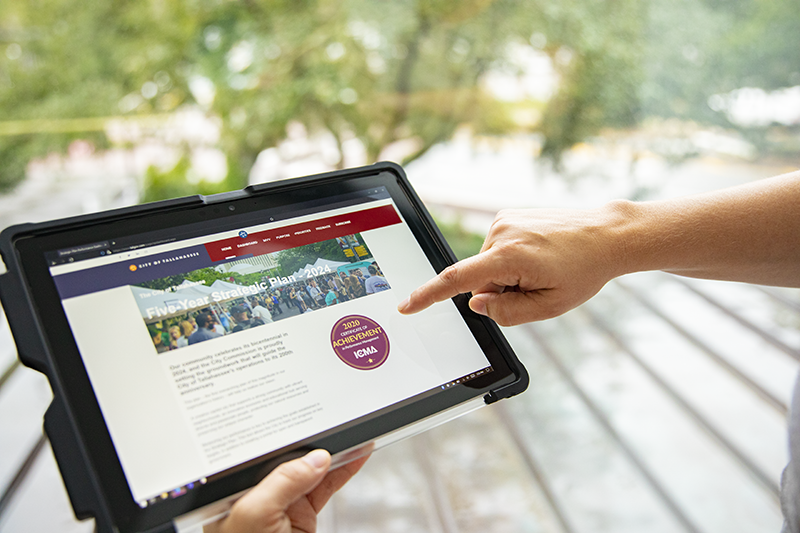
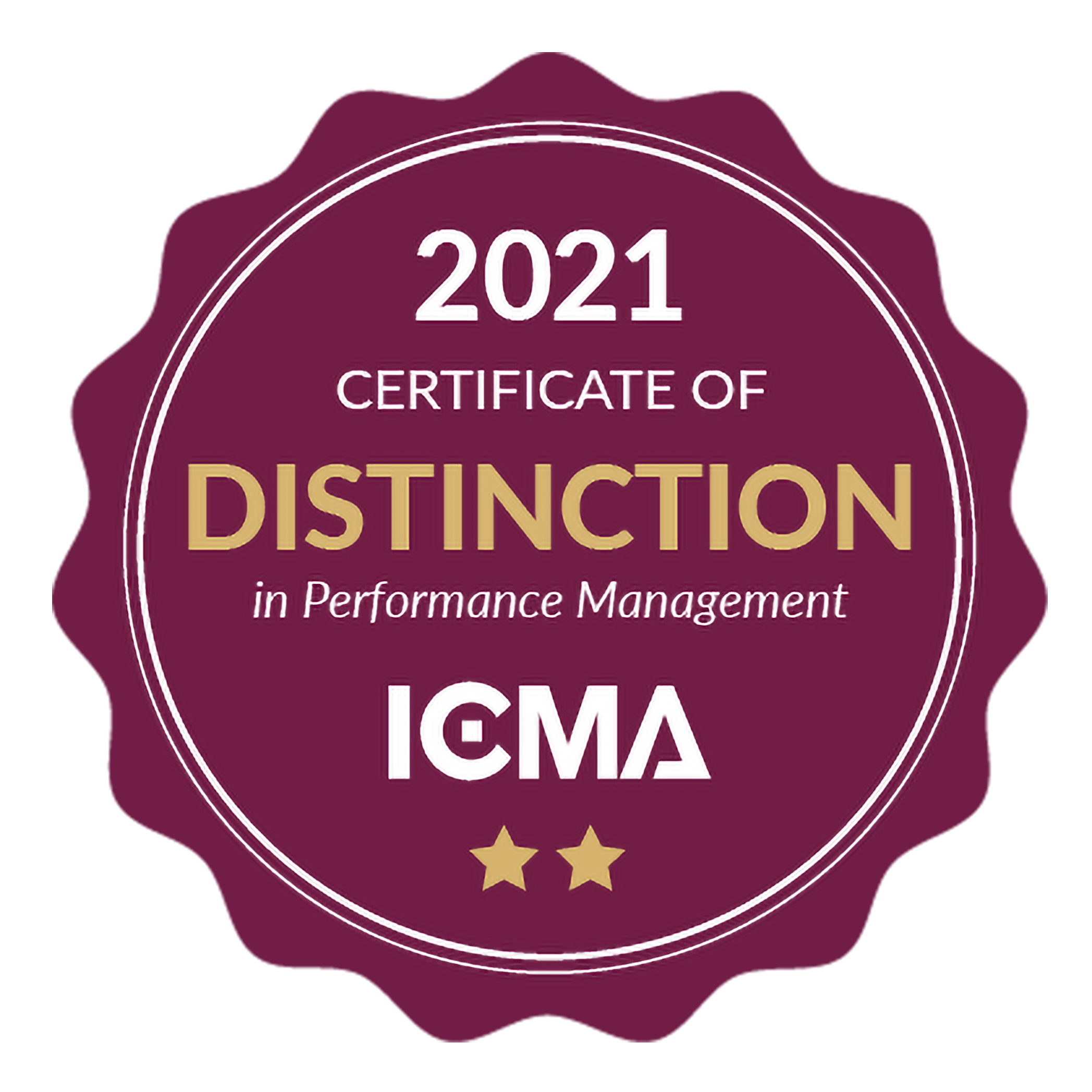 Click here to review the City’s performance dashboard. This page demonstrates progress towards the strategic plan’s objectives. Click here to review the City’s performance dashboard. This page demonstrates progress towards the strategic plan’s objectives.
5.4 Florida Benchmarking Consortium
Return to Top
The City of Tallahassee is a founding member of the Florida Benchmarking Consortium (FBC)*. It is the largest intra-state government benchmarking group in the United States. While the comparison numbers are older due to the timing of data collection, they still allow for benchmarking against peers.
* The Florida Benchmarking Consortium has felt the impact of COVID-19, and as such, there is a delay in obtaining updated statistical information in time for publication.
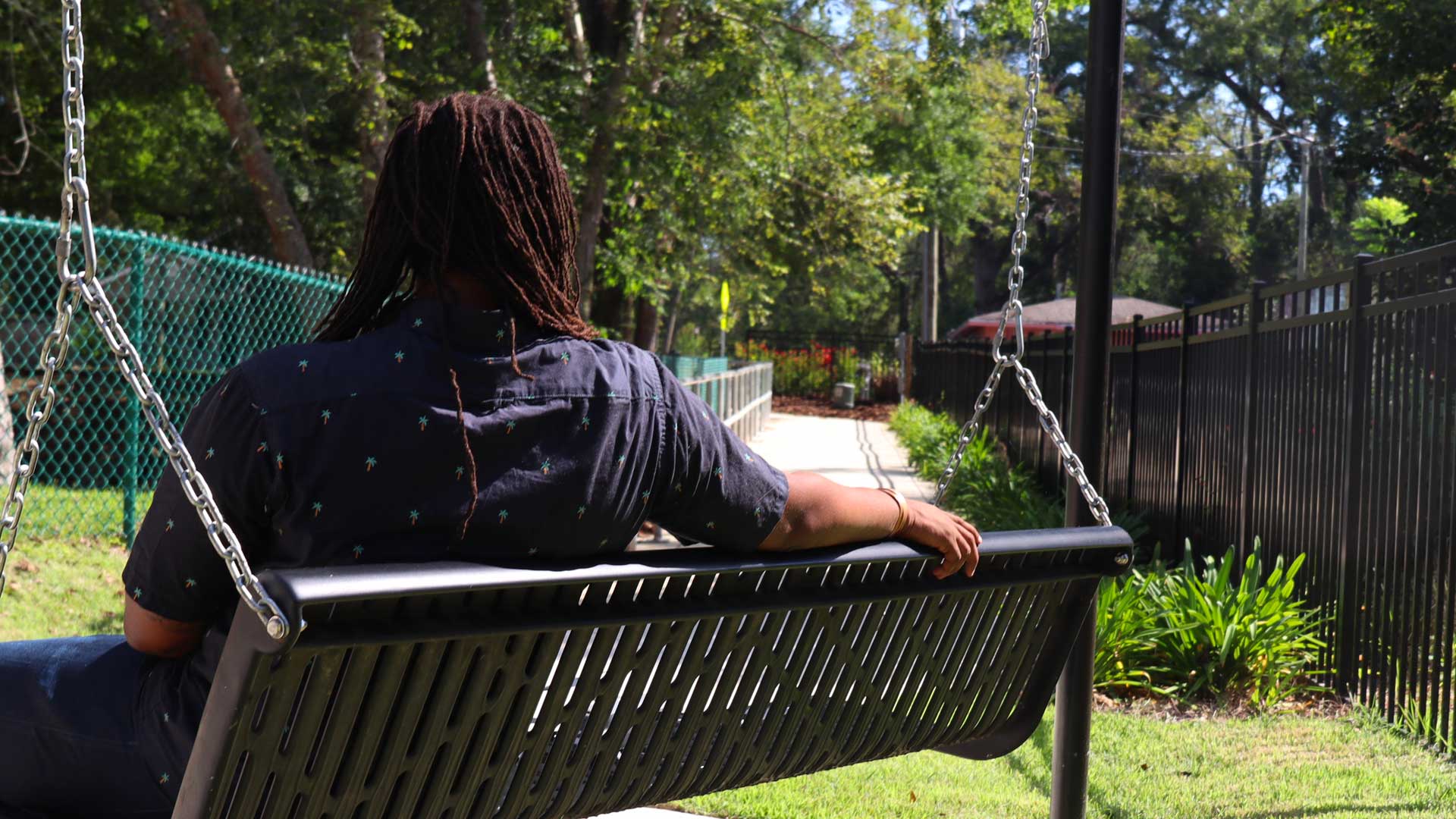
GFOA Budget Award
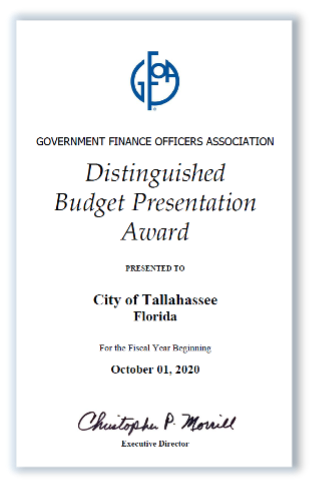
The City of Tallahassee was awarded the Distinguished Budget Presentation Award by the Government Finance Officers Association of the United States and Canada (GFOA) for the fiscal year 2021 budget, which is the 35th year the City of Tallahassee has received this award.
This award represents a significant achievement by the City. It reflects the commitment of the governing body, management, and staff to meeting the highest principles of governmental budgeting.
The City had to satisfy nationally recognized guidelines for effective budget presentation to receive the budget award. These guidelines assess how well an entity's budget serves as:
- a policy document
- a financial plan
- an operations guide
- a communications device
The budget presentation must be rated "proficient" in all four categories and the fourteen mandatory criteria within those categories to receive the award.
Special Thanks
Office of Economic Vitality
Office of Communications
Return to Top
ACCRUAL BASIS - A basis of accounting in which transactions are recognized at the time they are incurred, as opposed to when cash is received or spent.
AD VALOREM TAXES - Taxes levied on both real and personal property according to the property's valuation and the tax rate.
ADVERTISING - Costs for legal advertisements, posters, publication of public notices, resolutions, ordinances, and bid invitations.
APPROPRIATION - A legal authorization to incur obligations and to make expenditures for specific purposes.
AVAILABLE (UNDESIGNATED) FUND BALANCE - This refers to the funds remaining from the prior year which are available for appropriation and expenditure in the current year.
BAD DEBT - The estimated amount of accounts owed to the city (receivables) that will not be collected during the year. This includes utility accounts, accident damage repair accounts, and other miscellaneous account receivables which are deemed uncollectible.
BALANCED BUDGET- The revenues must equal the expenditures. Florida Statute 166 reads, “The amount available from taxation and other sources, including balances brought forward from prior fiscal years, must equal the total appropriations for expenditures and reserves."
BOND - Evidence of the local government's obligation to repay a specified principal amount on a future maturity date, plus interest. Bonds are issued to obtain money for capital projects. Revenue bonds pledge a particular source of revenue usually generated by the new asset as the means of repayment.
BOND REFERENDUM - The process by which voters approve or disapprove a proposed general obligation bond issue.
BOND REFINANCING - The payoff and re-issuance of bonds to obtain better interest rates and/or bond conditions.
BOND RESOLUTION - The document by which the local government authorizes the sale of bonds.
BUDGET - The formal allocation of resources (dollars) to various programs with the intent of performing a service.
BUDGETARY BASIS - The basis of accounting used to estimate financing sources and uses in the budget. This generally takes one of three forms: GAAP, cash, or modified accrual.
BUDGET CALENDAR - The schedule of key dates that the city follows in the preparation and adoption of the budget.
CAPITAL ASSETS - Assets of significant value and having a useful life of several years. Capital assets are also called fixed assets.
CAPITAL BUDGET - The appropriation of bonds or operating revenue for improvements to facilities and other infrastructure.
CAPITAL IMPROVEMENTS (Capital Projects) - Expenditures related to the acquisition, expansion, or rehabilitation of an element of the government's physical plant; sometimes referred to as infrastructure.
CAPITAL IMPROVEMENTS PLAN (CIP) - A plan for capital outlay to be incurred each year over a fixed number of years to meet capital needs arising from the government's long-term needs.
CAPITAL OUTLAY - Fixed assets which have a value of $750 or more and have a useful economic lifetime of more than one year or assets of any value if the nature of the item is such that it must be controlled for custody purposes as a fixed asset.
CAPITALIZED OVERHEAD - Charges assessed to capital projects for administrative and labor related services.
CAPITALIZED WAGES – Direct salaries or wages of city employees which are paid from funding appropriated in the capital budget.
CASH BASIS - A basis of accounting in which transactions are recognized only when cash is increased or decreased.
CITY CONTINGENCY - Amount budgeted to meet unexpected operating expenditures that occur during the current year.
COST OF GOODS SOLD (COGS) FUEL STORES - Fuel purchased by the city garage and then resold by the city for use in the city fleet.
COST OF GOODS SOLD (COGS) MATERIALS STORES - The cost of materials and supplies which are resold by the city. This includes articles for resale by the city garage parts division, the city warehouse, and golf courses.
COST OF GOODS SOLD (COGS) NATURAL GAS - This account represents the cost of natural gas purchased by the city electric department for use to generate electricity and natural gas sold by the gas utility department to gas customers.
COLLECTIVE BARGAINING AGREEMENT - A legal contract between the city and representatives of a recognized bargaining unit for specific terms and conditions of employment (e.g., hours, working conditions, salary, fringe benefits, and matters affecting health and safety of employees).
CONSUMER PRICE INDEX (CPI) - A statistical description of price levels provided by the U.S. Department of Labor. The index is used as a measure of the increase in the cost of living (i.e., economic inflation).
CONTRACTUAL SERVICES - Services rendered to the city by private firms, individuals, or other governmental agencies. Examples include maintenance agreements and professional consulting services.
CURRENT SERVICE LEVEL (CSL) - A level of service which is the same as the current year.
DEBT SERVICE - The amount of money needed to 1) pay interest on outstanding bonds, 2) pay the principal on maturing bonds, and 3) make contributions to a sinking fund for term bonds, debt service is calculated on a fiscal year basis.
DEDICATED TAX - A tax levied to support a specific government program or purpose.
DEFICIT - The excess of an entity's liabilities over its assets or the excess of expenditures or expenses over revenues during a single accounting period.
DEPARTMENT - Organizational unit of government, which is functionally unique in its delivery of services.
DEPRECIATION - Expiration in the service life of capital assets attributable to wear and tear, deterioration, action of the physical elements, inadequacy, or obsolescence.
EMPLOYEE BENEFITS - Costs incurred by the city for pension, health insurance, and other benefits provided to employees.
ENCUMBRANCE - The commitment of appropriated funds to purchase an item or service. To encumber funds means to set aside or commit funds for a specified future expenditure. ENTERPRISE FUND - A fund established for services that are predominantly self-supported by user fees and charges.
EQUIPMENT SUPPLIES - The cost of materials and supplies used in conjunction with the operation of machinery and equipment.
EXPENDITURE - The payment of cash or the transfer of property or services for the purpose of acquiring goods and/or services or settling a loss.
EXPENSE - Charges incurred (whether paid immediately or to be paid at a later date) for operations, maintenance, interest, or other charges.
FISCAL YEAR - A twelve-month period designated as the operating year for accounting and budgeting purposes in an organization. The fiscal year for the City of Tallahassee is October 1 through September 30.
FULL TIME EQUIVALENT (FTE) - A method of measuring the number of authorized employees based on a full-time equivalent of 2,080 hours per year.
FUND - A fiscal/accounting entity that is established to accomplish specific objectives and carry out specific activities. Examples: debt service fund, capital projects fund, and special assessment fund.
FUND BALANCE - The excess of the assets of a fund over its liabilities, reserves, and carryover.
GENERAL GOVERNMENT CAPITAL IMPROVEMENT FUND (GG/CIF) – Undesignated capital funding that serves as a contingency for all capital funding sources in the general government.
GENERAL GOVERNMENT CAPITAL PROJECT ACCOUNT (GG/CPA) – Funding provided from the general fund operating budget to support general government capital projects.
GENERALLY ACCEPTED ACCOUNTING PRINCIPLES (GAAP) - Uniform minimum standards for financial accounting and recording, encompassing the conventions, rules, and procedures that define accepted accounting principles.
GENERAL FUND - The fund used to finance all non- enterprise operations of local government.
GOAL - A statement of broad direction, purpose, or intent based on the needs of the community. A goal is general and timeless. Glossary of Key Terms
GRANT - A contribution by a government or other organization to support a particular function. Grants may be classified as either operational or capital, depending upon the intended usage of the grant proceeds.
INCREASED SERVICE LEVEL (ISL) - A change in service delivery which exceeds the current level of service.
INDIRECT COST - A cost necessary for the functioning of the organization as a whole that cannot be directly assigned to one service.
INFRASTRUCTURE - The physical assets of a government (e.g., streets, water works, sewer lines, public buildings, and parks).
IN LIEU OF TAXES - Income received by local governments to compensate for the loss of revenue from tax-exempt property.
INSURANCE - Costs associated with workers’ compensation claims including administration and medical costs, dishonesty bonds, and property and casualty insurance premiums.
INTER-FUND TRANSFER - Legally authorized transfers from a fund receiving revenue to a fund through which resources are to be expended.
INTEREST EXPENSE - Cost of utilizing borrowed funds (long-term debt).
INTERGOVERNMENTAL REVENUE OR SHARED REVENUE - Tax/fee money collected by one level of government and distributed to another level of government.
INTERNAL SERVICE FUNDS - Funds established to distribute costs to user departments for administrative services provided by another unit of government, such as data processing or insurance funded from a central pool.
INTRA-FUND TRANSFER - Legally authorized transfers within a fund.
LEVY - To impose taxes for the support of government activities.
LONG-TERM DEBT - Debt with a maturity of more than one year after the date of issuance.
MILLAGE RATE - The rate in mills (1 mill = 1/1000 of a dollar or .001) at which property is taxed.
MISSION STATEMENT - A formal summary of the aims and values of a company or organization.
OBJECTIVE - A specific/quantifiable statement of what the city, a department, or a unit expects to accomplish in a fiscal year.
OFFICE EQUIPMENT - Furniture, fixtures and equipment with an initial cost of $750 or more.
OPERATING REVENUE - Funds received by the city as income to pay for on-going operations, including taxes, fees, interest earnings, and grant revenues.
OPERATING EXPENSES - The cost for personnel, materials, and equipment required for a department to function.
ORDINANCE - Legislation enacted by the City Commission which has the full force and effect of law within the municipal boundaries.
ORGANIZATIONAL CHART - A graphic representation of the structure of an organization, showing the relationships of the positions or jobs within it.
OTHER SALARY ADJUSTMENTS - Items of employee compensation that are not directly related to the regular or overtime hours worked.
OVERTIME - Compensation to eligible employees for hours worked beyond 40 hours within a specific workweek.
PAY-AS-YOU-GO BASIS - A term used to describe a financial policy by which capital projects (infrastructure) are financed from current revenues rather than through borrowing.
PENSION CURRENT - City contribution to employee pension plan for participating employees.
PENSION MATCHED ANNUITY PENSION PLAN (MAPP) - City contribution to employee matched annuity pension plan for participating employees.
PER CAPITA COST - Cost per unit of population to provide a particular service in the community.
PERFORMANCE INDICATORS - Specific quantitative and qualitative measures of work planned by specific departments or programs.
PERFORMANCE MEASURE - Data collected to determine how effective or efficient a program is in achieving its objectives (performance indicators).
PRIOR-YEAR ENCUMBRANCES - Unpaid, legally binding obligations from previous fiscal years in the form of purchase orders, contracts, or salary commitments, which are chargeable to a prior appropriation and for which a part of that appropriation is reserved.
PRO-FORMA - The financial assumptions or projections for the 14 operating funds.
PROGRAM - A collection of activities directed at accomplishing similar objectives.
PROGRAM PERFORMANCE BUDGET - A method of budgeting whereby the services provided to the residents are broken down in identifiable service or performance units and funding is appropriated for a given level of service or units.
PROPERTY TAX - An ad valorem tax based on the fair market value of real property (land and buildings) and personal property (business equipment). Fair market or "just" value is determined by the county property appraiser as of January 1 of each year, under the guidelines of Chapter 193, Florida Statutes.
REDUCED SERVICE LEVEL (RSL) - A level of program service which is less than that of the current year.
REPAIRS, REPLACEMENTS & IMPROVEMENTS (RR&I) - The portion of the cost of fixed assets (excluding land) charged as an expense during a particular period due to expiration in service life, attributable to wear and tear through use and lapse of time, obsolescence, inadequacy, or other physical or functional cause.
RESERVE - An account used either to set aside budgeted revenues that are not required for expenditure in the current budget year or to earmark revenues for a specific future purpose.
RESERVE TRANSFER - Those payments necessary to adequately meet the current requirements for reserve funds.
RESOLUTION - A special or temporary order of a legislative body that requires less legal formality than an ordinance or statute.
REVENUE - Money that flows into the local government. It is recurring if it is received on a consistent basis (e.g., sales taxes and property taxes) and nonrecurring if it is received irregularly (e.g., federal and state grants). The four main types of local revenue are taxes, user fees, licenses and permits, and intergovernmental revenue. ROLLED-BACK MILLAGE RATE - A tax rate, which applied to the current year’s tax base, will bring in the same amount of taxes as levied the prior year. Newly constructed property or other property added to or deleted from the prior year‘s base is excluded.
SALARIES AND WAGES - Regular weekly and monthly compensation for work performed as defined by the personnel pay scale for position classifications.
SERVICE LEVEL - Services or products which comprise actual or expected output of a given program.
SOCIAL SECURITY - City contribution to employee Social Security for participating employees.
SPECIAL ASSESSMENT - A tax on property owners who receive a benefit not received by all other taxpayers.
SPECIAL REVENUE FUND- Special revenue funds are used to account for and report the proceeds of specific revenue sources that are restricted or committed to expenditure for specified purposes other than debt service or capital projects.
SUPPLEMENTAL APPROPRIATION - An additional appropriation made by the governing body after the budget year has started.
TAX BASE - The total taxable value of property within the local government's legal boundaries.
TAX ROLL - The master list of the assessed value of all taxable property within the government's jurisdiction. The list is certified to all local taxing authorities by the property appraiser by July 1 of each year.
TAXABLE VALUE - The assessed value of property less exemptions.
TAXES - Compulsory charges levied by a government for the purpose of financing services for the common benefit of the people.
TEMPORARY WAGES - Seasonal or temporary employees' compensation computed on hourly or monthly rates.
TERM BONDS - Bonds comprising a large part or all of a particular bond issue which come due in a single maturity.
TRAVEL AND TRAINING - The cost of attending meetings, conferences, short conferences, etc.
TRUST FUND - A fund established to collect and distribute monies for a specific function or operation.
UNCLASSIFIED EQUIPMENT - New equipment not otherwise classified, including air conditioners, traffic signals, field stripers, water fountains, etc. This includes all tangible personal property to be purchased which has a value of $1,000 or more. This equipment, as with all capital equipment, is subject to inventory control.
UNCLASSIFIED PROFESSIONAL FEES - The cost of personnel service under expressed or implied contracts to individuals, companies, or corporations engaged as a contractor to perform a specific professional or expert service for the city.
UNCLASSIFIED SUPPLIES - Consumable materials and supplies used in conjunction with projects or operations not specifically classified.
AHAP Affordable Housing Assistance Program
CAD Computer Aided Dispatch
CDA Consolidated Dispatch Agency
CDBG Community Development Block Grant
CHSP Community Human Service Partnership
CIP Capital Improvement Plan
CIS Customer Information System
COCA Council on Culture and Arts
COPS Community-Oriented Policing Services
CPI Consumer Price Index
CRA Community Redevelopment Agency
CUSB Consolidated Utility System Bond
DEP Department of Environmental Protection
DIA Downtown Improvement Authority
DRI Development of Regional Impact
EAP Employee Assistance Program
EEO Equal Employment Opportunity
EOC Emergency Operations Center
ERU Equivalent Residential Unit
EWD Equity and Workforce Development
FAA Federal Aviation Authority
FAMU Florida Agricultural and Mechanical University
FDEP Florida Department of Environmental Protection
FDOT Florida Department of Transportation
FEMA Federal Emergency Management Agency
FERC Federal Energy Regulatory Commission
FHWA Federal Highway Administration
FSU Florida State University
FTA Federal Transportation Administration
FTE Full-time Equivalent
GASB Governmental Accounting Standards Board
GF General Fund
GG/CIF General Government/Capital Improvement Fund
GG/CPA General Government/Capital Projects Account
GIS Geographic Information Systems
HOME Home Investment Partnership Program
HUD Housing and Urban Development
IAFF International Association of Firefighters
IRP Integrated Resource Planning
ISO Insurance Service Office
ISS Information Systems Services
JARC Juvenile Assessment Receiving Center
KWH Kilowatt Hour
LLEB Local Law Enforcement Block Grant
MAPP Matched Annuity Pension Plan
MGD Million Gallons Daily
MSA Metropolitan Statistical Area
MW Megawatt
MWBE Minority and Women Business Enterprise
NPDES National Pollution Discharge Elimination System
OEV Office of Economic Vitality
PASS Pedestrian and Street Safety
PBA Police Benevolent Association
PETS Permit Enforcement Tracking System
PLACE Planning, Land Management & Community Enhancement
PSC Public Service Commission
PUD Planned Unit Development
RFP Request for Proposal
RR&I Repairs, Replacements, and Improvements
SCADA System Control and Data Acquisition
SHIP State Housing Initiative Plan
SPRP Stormwater Pollution Reduction Program
TCC Tallahassee Community College
6.3 Resolutions
Return to Top
Resolution Budget
Resolution Millage
6.4 Online Budget Feedback
Return to Top
Thank you for reading the City of Tallahassee’s budget. To foster its continuous improvement, please complete a short survey to provide some feedback. Click here to complete the survey.
TAKE THE FY2022 BUDGET FEEDBACK SURVEY
6.5 Form of Government
Return to Top
The City of Tallahassee uses the council-manager form of government with a “leadership mayor”.
The mayor, whose role includes presiding at city commission meetings, serving as the ceremonial head of the government, serving as the official head of the City for civil processes, and executing legal documents. The mayor is also considered the political leader of the government and is involved in dialogues and negotiations with county, state, and federal officials. Tallahassee's mayor is not considered a "strong mayor" because the position has no veto power and represents only one vote on the city commission.
The mayor and city commission serve as the governing body of the City. They set policies and rules by which the City is operated. They also establish goals and tax rates. The mayor and city commissioners each serve four-year terms. The terms of office are staggered, with elections held in even-numbered years (two seats during Presidential election cycles, and two others - plus the mayor - in mid-term election cycles).
Regular city commission meetings are typically held twice a month to conduct city business and provide citizens with an opportunity to participate in the government process. In addition, the commission meets for workshops on specific issues. The city commission also appoints four officers to administer the duties of the city.
Four officers, appointed by the city commission, handle the administration of the City: city manager, treasurer-clerk, city attorney, and inspector general. The city manager oversees most City departments and administers the daily operation of the City. The treasurer-clerk administers records, taxation, and the City treasury. The city attorney serves as the City's legal advisor, prepares contracts, and represents the City in legal issues. The auditor reviews the policies, procedures, and accounting of City operations.
The independent Ethics Board was created in accordance with voters' approval of a City Charter amendment during the November, 2014 general election. Approval of the referendum created a 7-member Board comprised of 5 seats designated for appointment by local entities including the City Commission, Public Defender, State Attorney for the Second Judicial Circuit, President of Florida State University, and President of Florida A & M University. The referendum required these initial 5 Board members to select two additional members to bring the Board to a full complement of 7 members.
The independent Ethics Board and Ethics Officer provide ethical oversight of the City’s elected and appointed officials. Click here to visit their website.
6.6 Supplemental Demographic and Economic Information
Return to Top
This section offers additional information and visualizations related to the City’s community. It also describes economic trends that impact the City’s budget. For more information on these trends, please visit the Tallahassee-Leon County Office of Economic Vitality’s website.
The Tallahassee Metropolitan Statistical Area (MSA) is used frequently, which includes all of Gadsden, Jefferson, Leon and Wakulla counties. The City serves as an urban hub to these areas and many in outside communities work and shop within the City’s limits.
The example graph below shows the growth of median sales price of homes in Tallahassee, Leon County, and the State of Florida.
Educational Attainment
Tallahassee citizens are some of the most educated in the State of Florida. In 2018, 48% of its citizens had a bachelor’s degree or higher compared to 29% for the State as a whole.
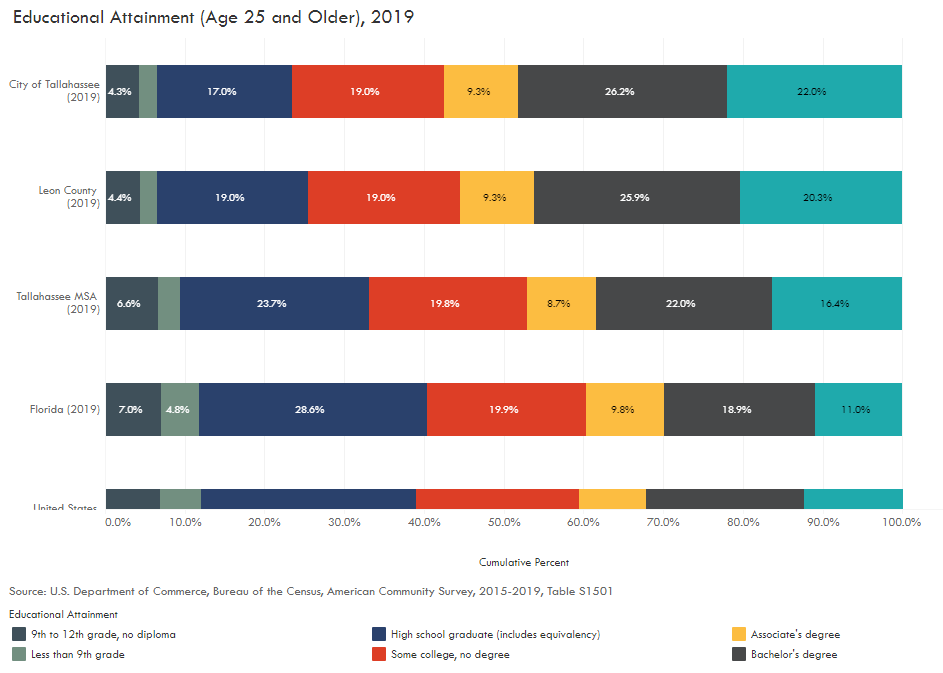
Explore the most recent data and interactive views.
Population by Age
The City boasts a large student population with 20 to 24 year-old residents representing the largest 4-year age group. With the areas around the universities resembling college towns, the student populations impact the City’s statistics from poverty to homeownership.
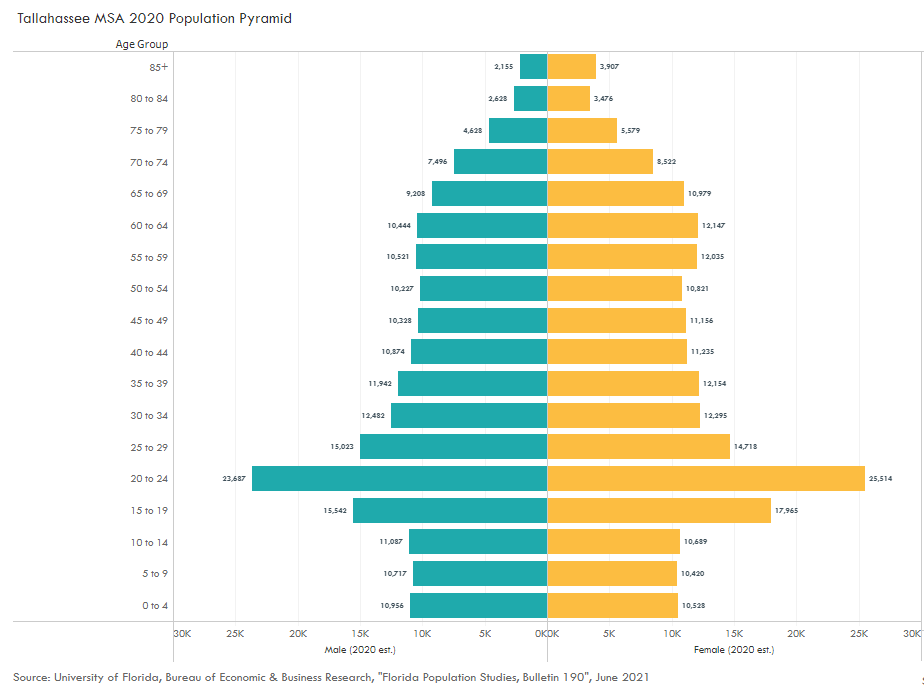
Explore the most recent data and interactive views.
Growth by Age Group
While students may represent a large single group, the fastest growing age group are those from 65 to 79. This is in part due to State-wide trends but also thanks to the Choose Tallahassee campaign.
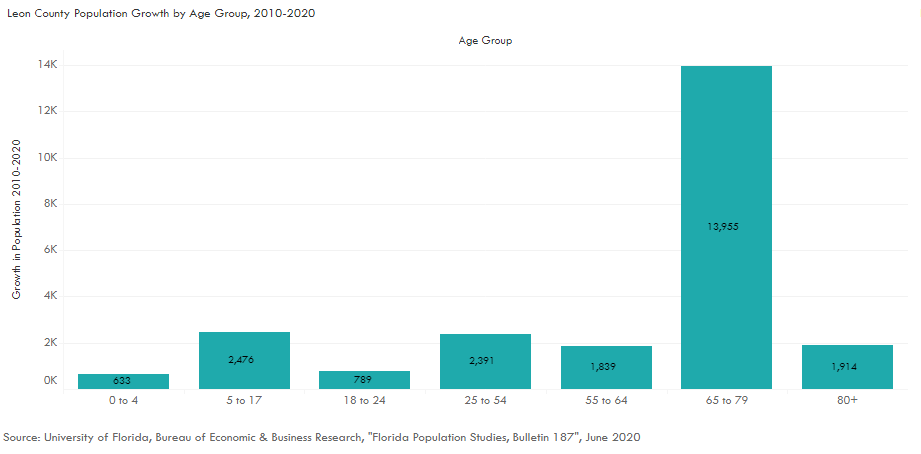
Explore the most recent data and interactive views.
Crime Index
While crime has been a point of concern for the community, it’s important to note that the crime rate has been in decline. Since 1995, violent crime has declined by over 50%.
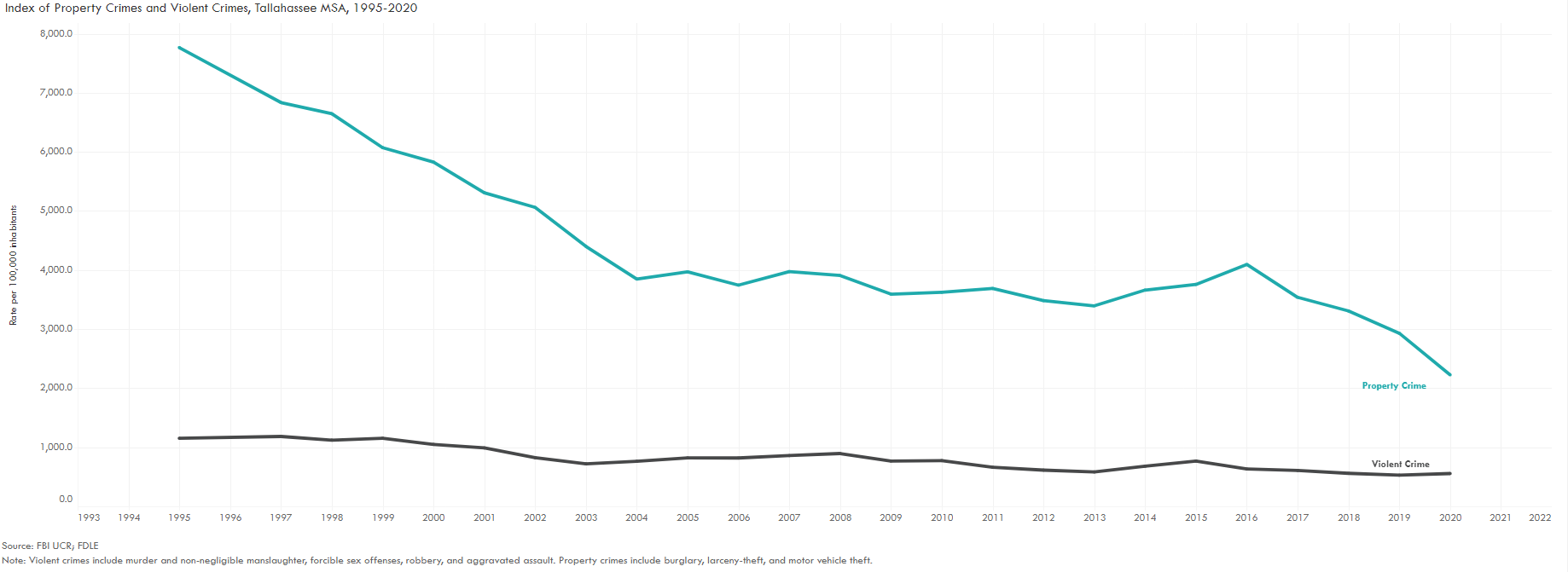
Explore the most recent data and interactive views.
Electric Service Points
The City’s electric utility serves more customers each year, which represents both growing revenues and costs for the Electric Fund. Regular spikes in the early fall are likely due to students moving in and out of properties in those months.

Explore the most recent data and interactive views.
Tallahassee Airport Passengers
While the Tallahassee Airport does much more than serve passenger aircraft, it’s an important trend to monitor for the Aviation Fund. The tremendous impact of COVID-19 on air travel also impacted the City’s airport. This will be an important trend to monitor for the City and its Aviation Fund.
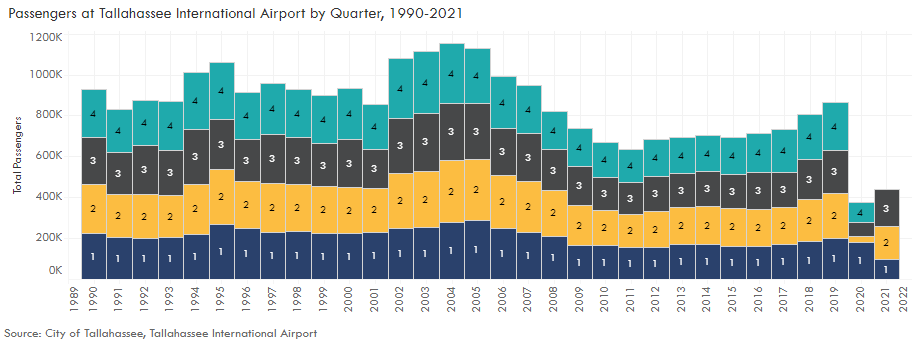
Explore the most recent data and interactive views.
Homeownership Rate
Leon County has a lower homeownership rate than many other counties and the State of Florida overall. This is due to the large student population referenced earlier.
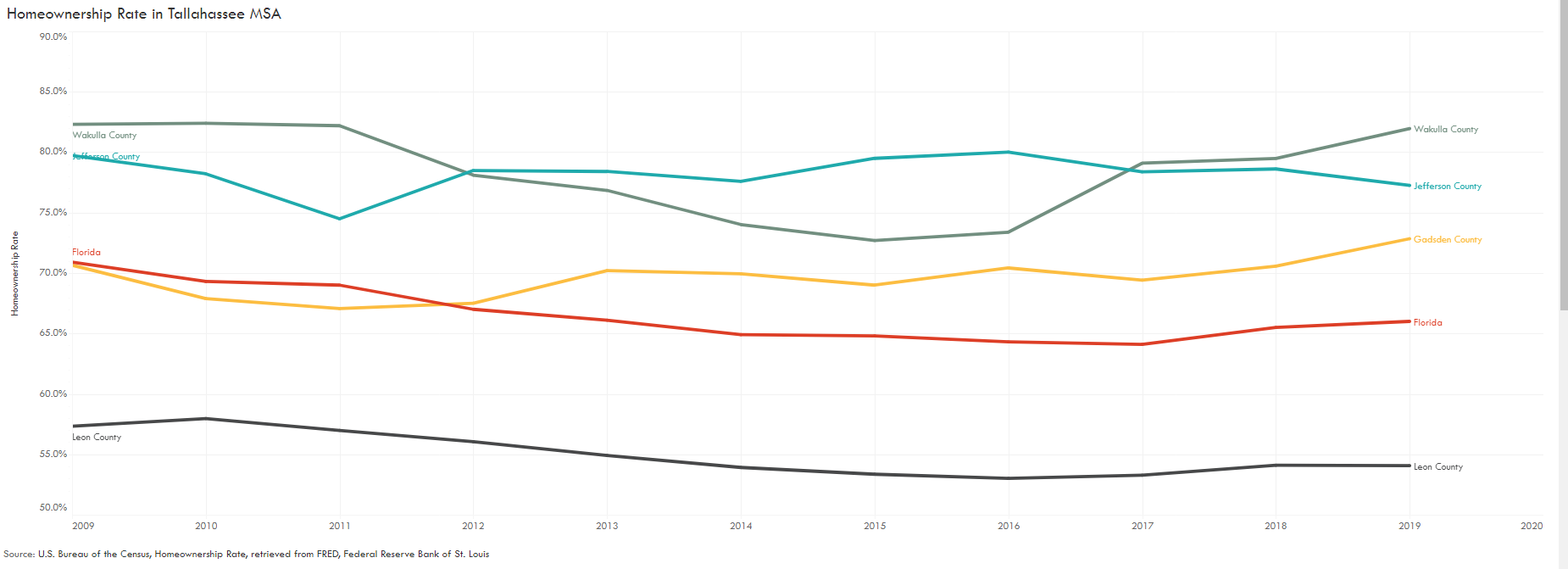
Explore the most recent data and interactive views.
Taxable Sales
Taxable sales affect the revenue-sharing with the State of Florida.

Explore the most recent data and interactive views.
Foreclosures
In this recession environment, it will be important to monitor local foreclosures. Stimulus from the federal government delayed the impacts of late mortgage payments, but foreclosures are expected to rise into 2021.
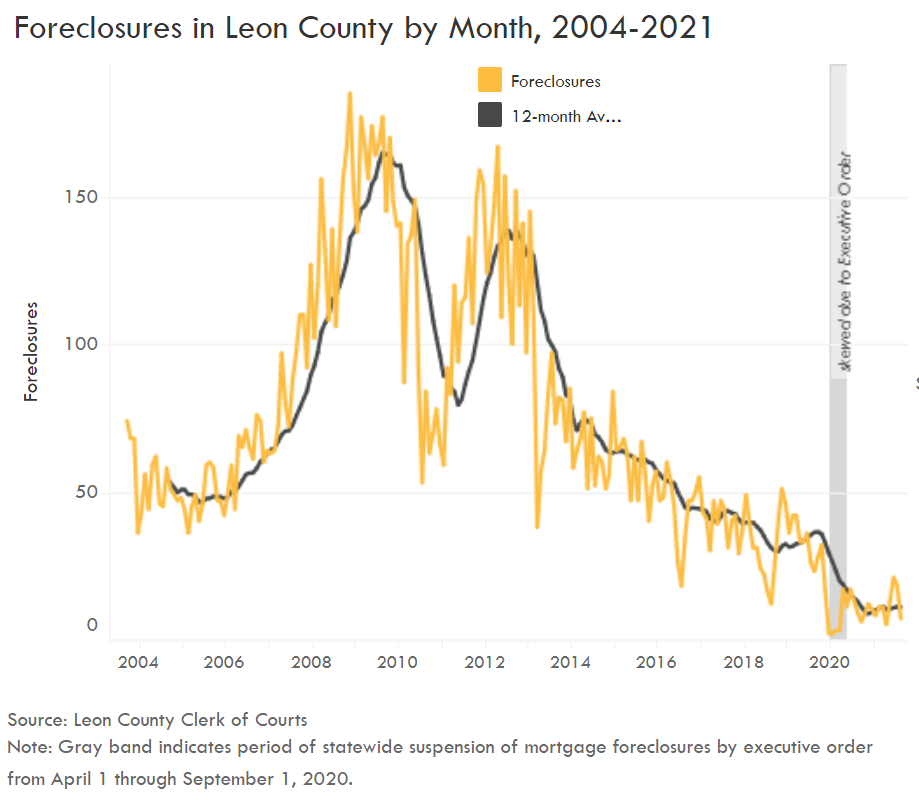
Explore the most recent data and interactive views.
|